Something that has emerged for me as part of the PDP are themes of authenticity and intentionality. I find them running through many aspects of my practice and curricular design is no exception.
Curriculum | Discipline Design
Just as I hope to help students get a sense that science is a process that is never truly “done,” I feel the same about my curriculum. I am frequently considering changes throughout my classes, from small ones such as a clarification on a rubric or assignment instruction, to larger themes covered in courses.
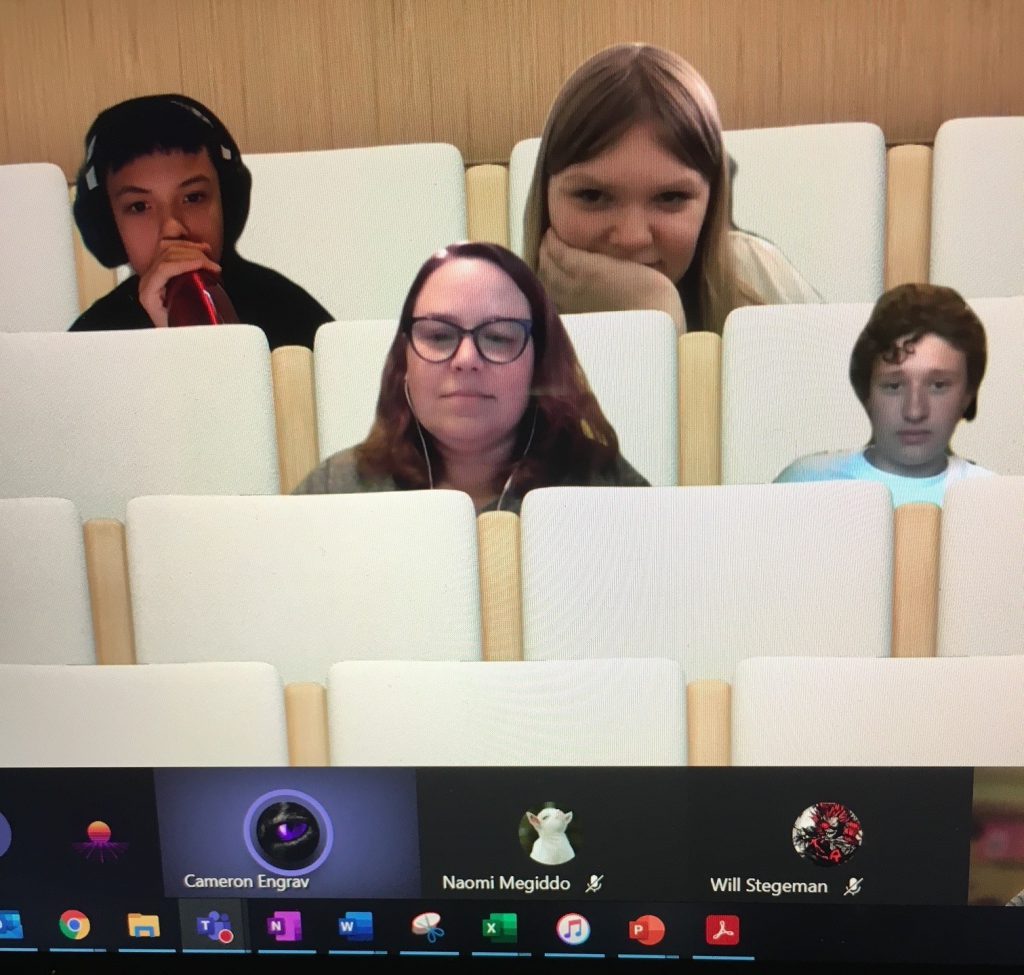
(1) designs and implements courses that reflect teacher mastery of their academic discipline and its teaching methodologies
The teaching methodologies in Science in many ways emulate the “doing” of science. To that end, students are given many opportunities to engage with different aspects of what are often referred to as “the scientific method.” Growing up, that was taught to me as a somewhat rigid sequence of steps, but what we try to do in our classes at EPS is to instead show how these aren’t static but instead can flow from one to the next, although there are certain fundamental aspects. For example, we spend a lot of time focusing on what constitutes a “scientific question,” since asking questions is a key component of any scientific process.
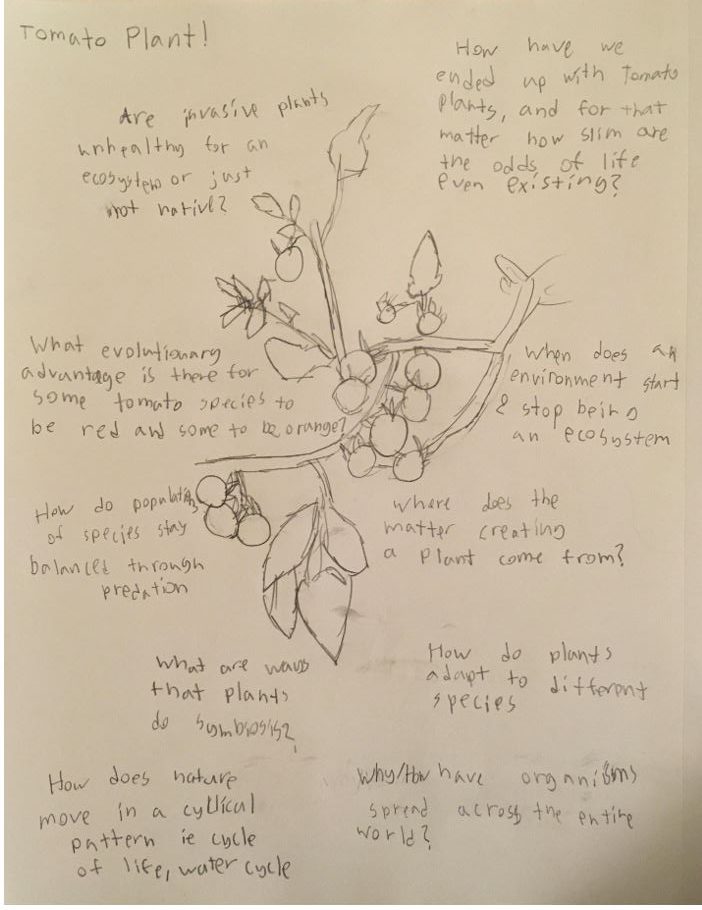
That connects to generating hypotheses and helping students ask questions and make predictions so that they can then gather evidence to try to answer those questions (and determine whether or not their predictions were supported by their data). Asking students to grapple with unknowns and take risks is something that I believe is done in all of the science classes at EPS.
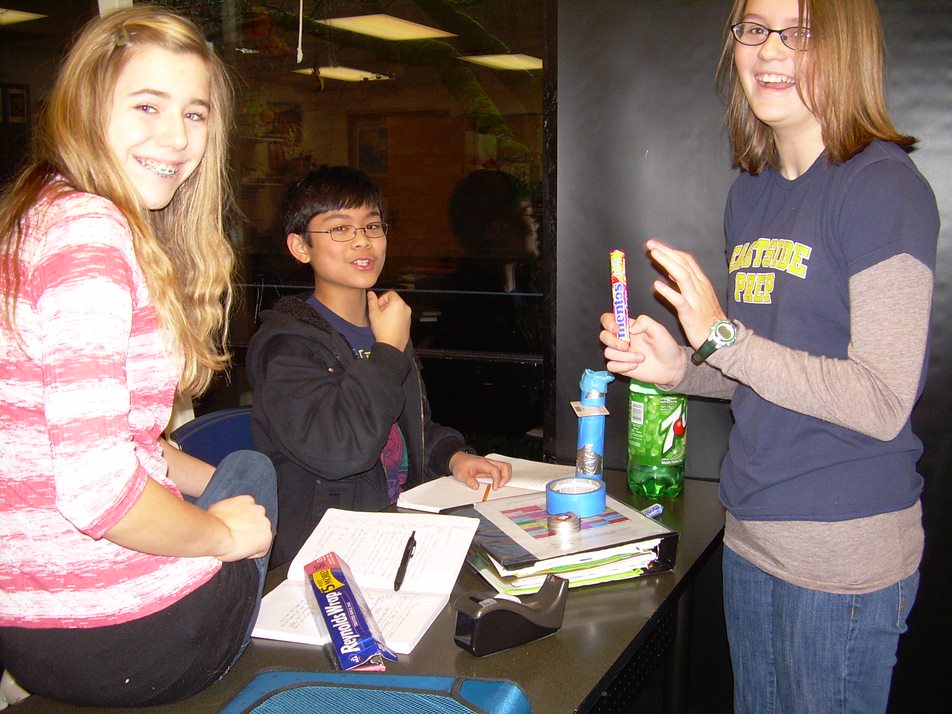
I am a member of the National Science Teachers’ Association (NSTA) and subscribe to several of their listservs to get emails from other community members with questions or suggestions for specific lessons or teaching strategies. This helps me pull from a larger group and access some helpful collective knowledge. I also get their magazines, although at this point I have a bit of a backlog that I need to go through to search for potential new lesson plans or modifications of existing ones.
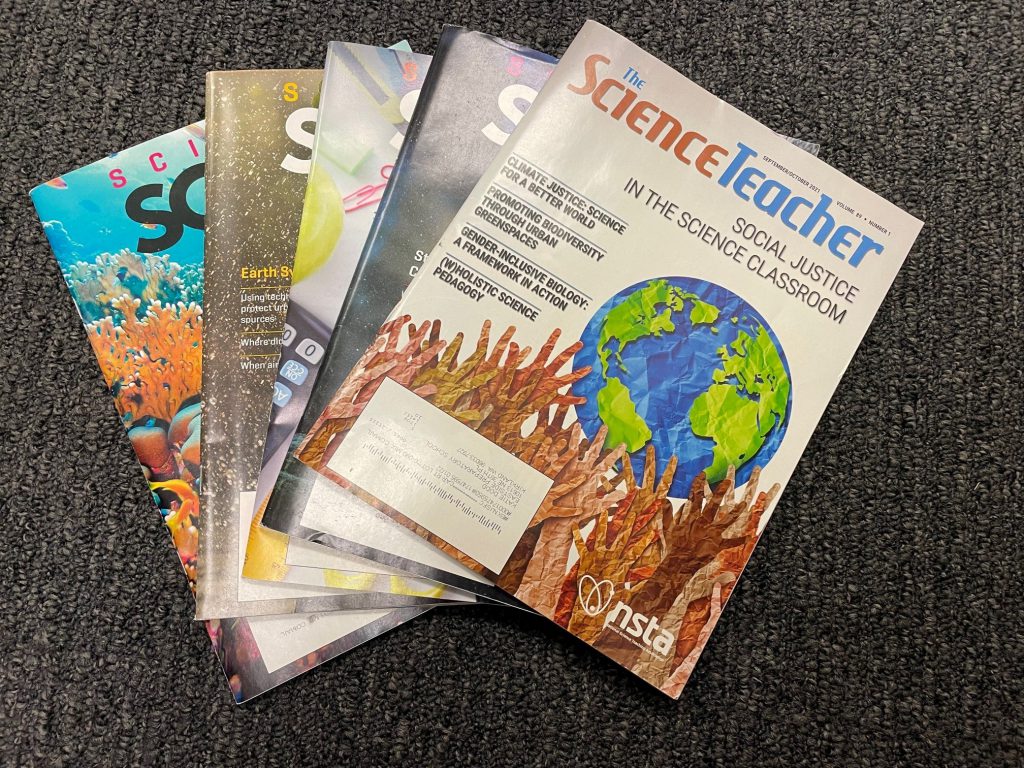
I’ve also participated in various professional development opportunities connected to science teaching, but those will be discussed in the Program and Professional Development section.
In my first two years at EPS, I taught science content that was not directly my background. My academic studies focused on the life sciences, but my first two classes were Scientific Thinking 1 (physical science) and Scientific Thinking 3 (Earth science).
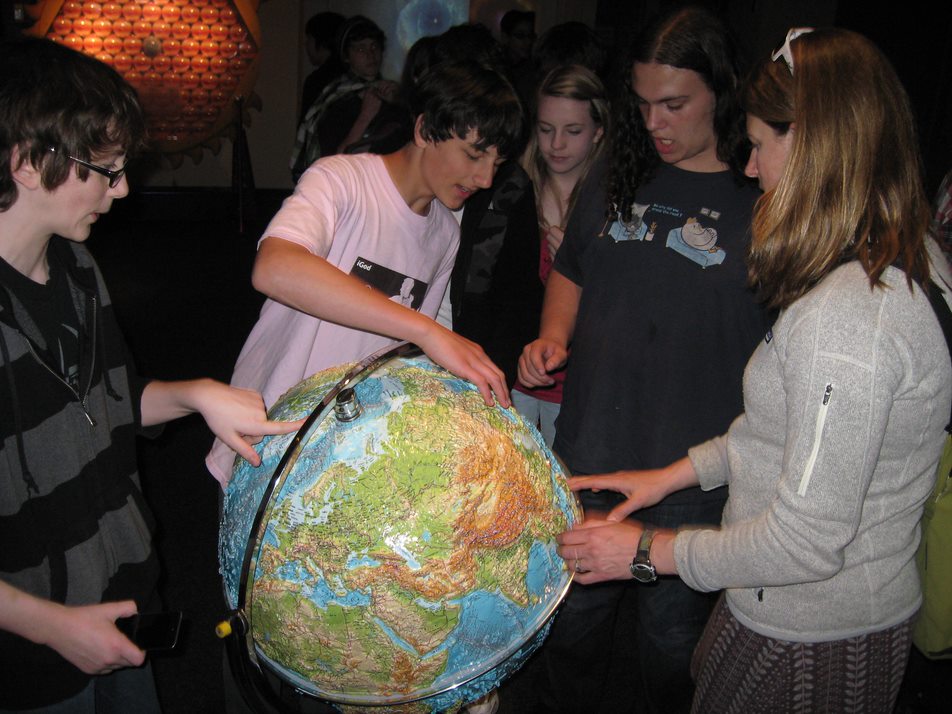
Those courses were initially a bit of a challenge as I had to relearn many science concepts that I hadn’t spent much time thinking about in recent years.
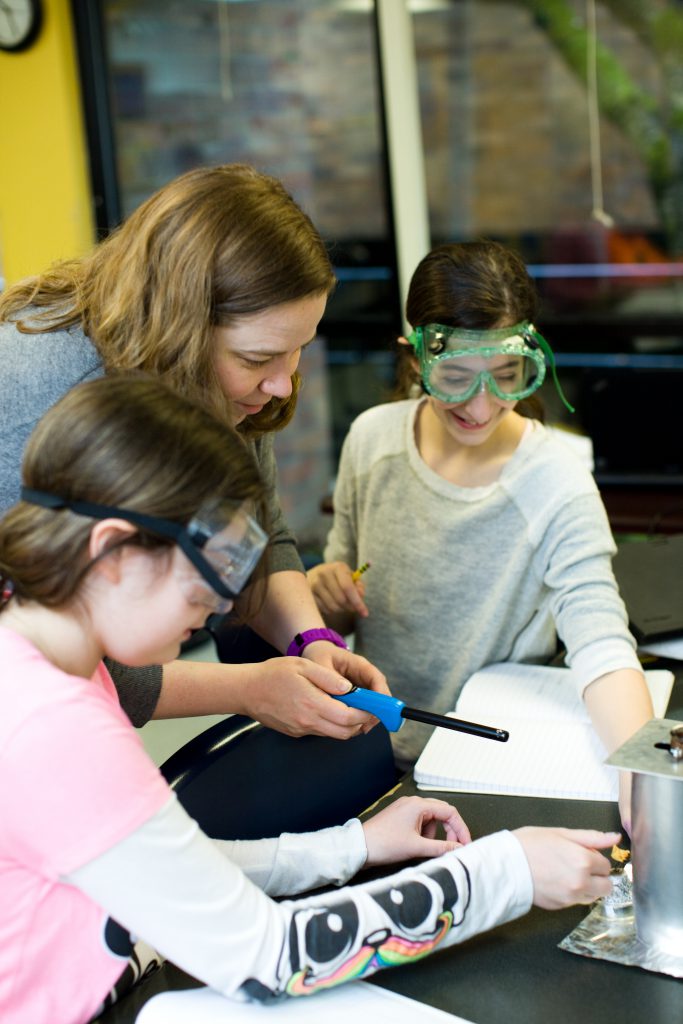
When the opportunity to came up to switch to Scientific Thinking 2 (life science) instead of ST3, I jumped on it, as this allowed me to teach from more firmly within my wheelhouse, at least for one of my preps. I taught ST1 for many more years, though (I think seven in total?), and found it a little hard to give it up as I grew to really enjoy working with those students and that curriculum. But at the end of the day, I was drawn most strongly to the life science curriculum as that connected with my favorite content to teach.
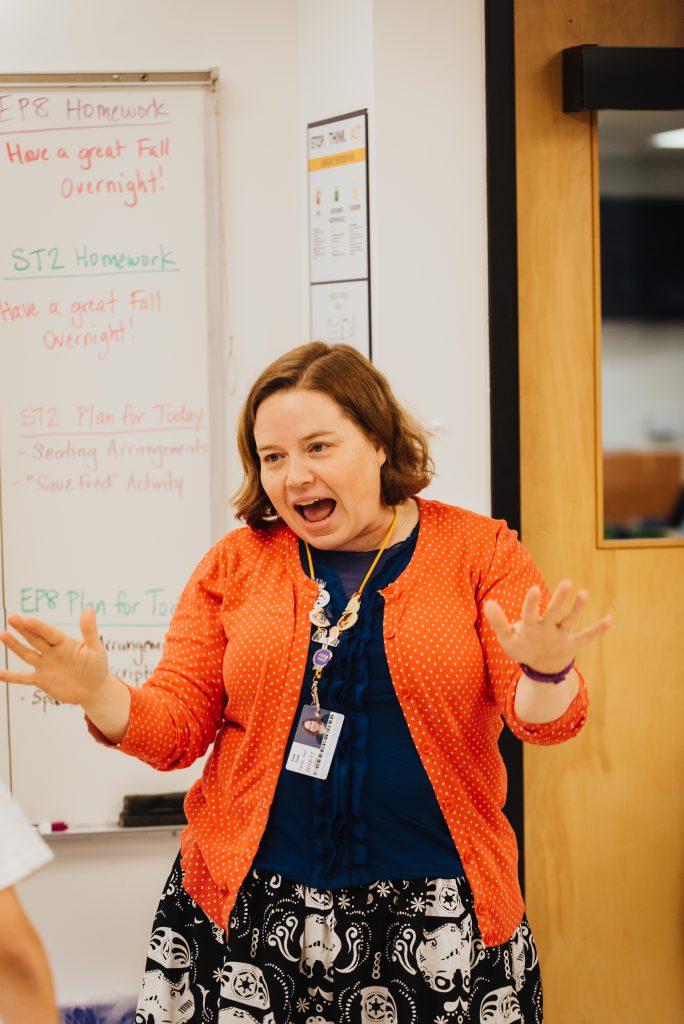
When the Science discipline proposed new trimester classes for the Upper School, this provided me with opportunities to build courses from the ground up and really tap into both my educational and professional background as a former fisheries biologist. The Ecology curriculum was developed in collaboration with Nickie Wallace, as we proposed the class together. Initially, the thinking was that Nickie would be the one to teach the class, but with the way the FTEs worked out, it ended up being “my” class. Nickie was a great collaborator as I worked to turn our proposal into a more fleshed-out curriculum, particularly when it came to writing Upper School level tests, which was something that I had not done for many years. Burton Barrager was a helpful sounding board as I thought about the Marine Biology curriculum specifically.
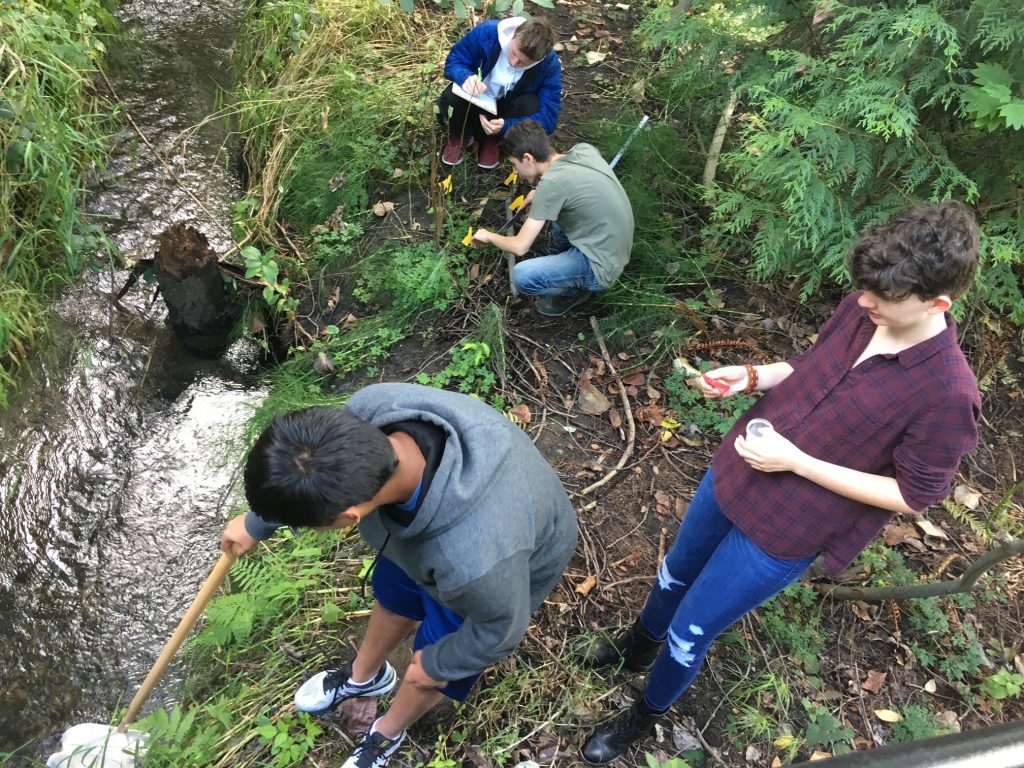
I’ve already talked a bit about the design of the major assessments in both of these Upper School courses in the Differentiated Instruction category. For the rest of the classes’ scope and sequence, I have worked to model them on the kinds of courses that I took as an undergraduate. This is particularly true of the Marine Biology class, where some lectures and labs are based directly on ones that I either did as an undergraduate or taught as a graduate student. I would say that the greatest challenge for me in that class is that I am so excited about this content that I have had to make tough choices about what can be included in a trimester class. I think that this enthusiasm comes through for students enrolled in this class, and that when it is coupled with my extensive background knowledge of most of this content, it creates a great learning atmosphere.
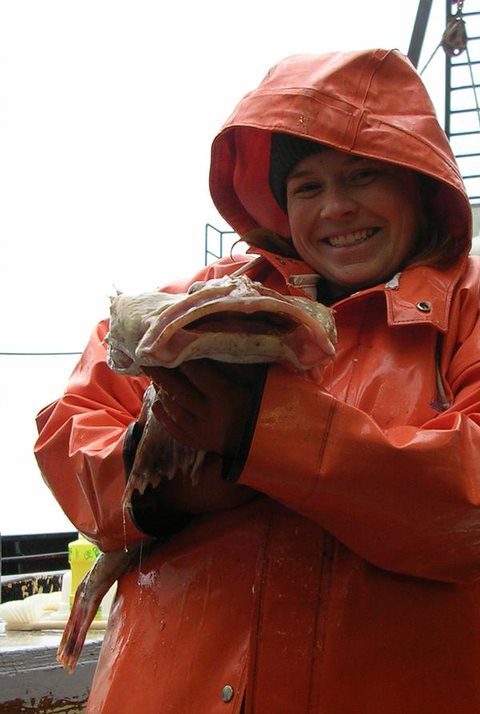
When I think about designing courses, though, I also think about the student experience and where their interests lie, which to me feels like it’s something that’s missing from this indicator. For all of these courses there are far more things that fall under those headings than could be covered in a trimester or even a year-long class, so by necessity there are choices made about what’s covered. I also consider what is developmentally appropriate. For example, I intentionally don’t do much with molecular biology in the 7th grade class as a lot of it is too abstract for many of the students who may still think pretty concretely at this age. I know that they will receive a much greater focus on this content in their Upper School biology classes.
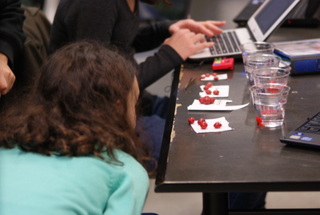
(2) designs and implements courses framed by the school’s pedagogical tenets – inquiry, experience, and integration
To my mind, science is an area that lends itself naturally to inquiry and experiential learning, particularly in a hands-on way. In fact, it’s quite challenging to teach it without incorporating these approaches, which was driven home during remote and hybrid teaching, which made the hands-on part extremely difficult.
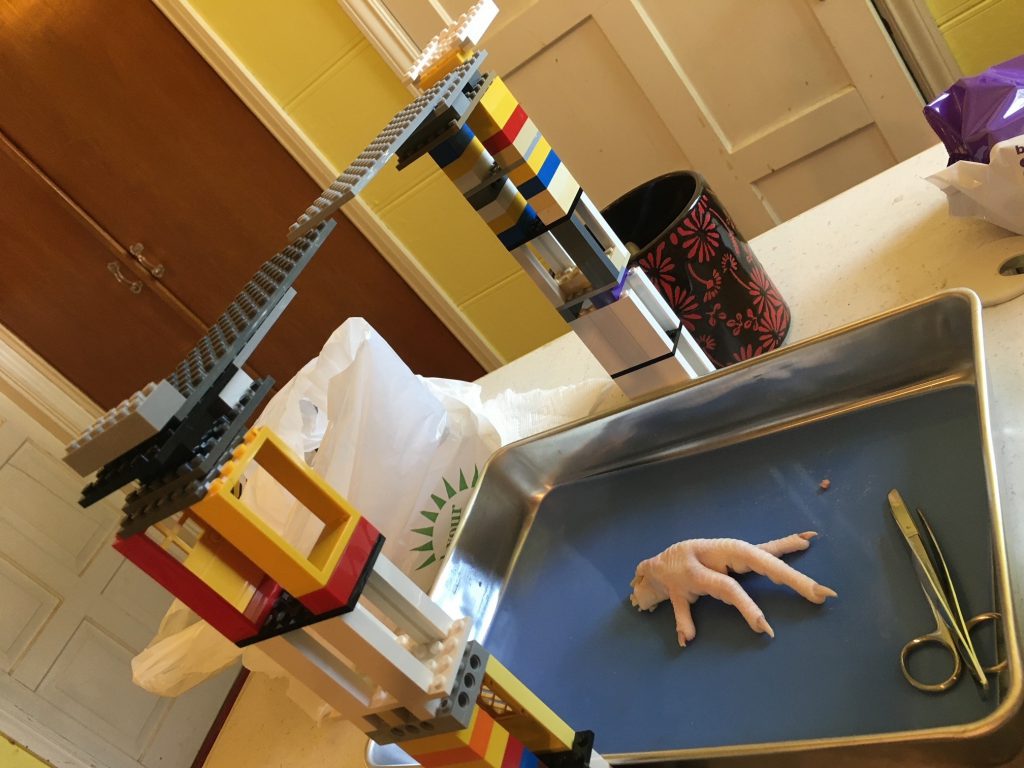
All of my classes incorporate numerous hands-on projects connecting to the curriculum. Looking at just the fall trimester of Scientific Thinking 2 as an example, students have nine different activities (listed below) with hands-on components, some of which are multi-day experiments.
- Save Squirmy
- Using the Microscope
- Pond Water Examination
- Isopod Lab
- Seeing Cells
- Cell Analogy Project
- Egg Osmosis Lab
- Unicorn Mating
- Dragon Babies
In many labs, students have choice about how they will approach the experimental question (for example, choosing stimuli in the Isopod Behavior Lab or liquids for the Egg Osmosis Lab), which means that students are not working in lockstep but instead are exploring questions from slightly different angles.
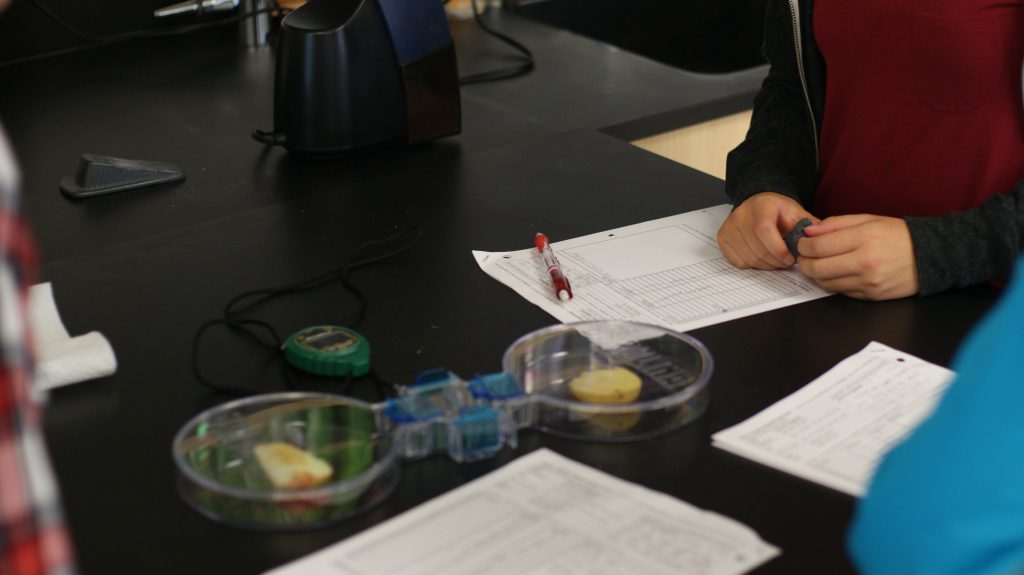
They are also more invested in the process and the outcome as they feel a sense of ownership. Field trips are of course another opportunity for experience-based learning, and were discussed in some depth already in the fourth Pedagogical Practice indicator.
One example of a topic that I have modified over the years is the way that reproduction of flowering plants is taught in ST2. Previously, the work was much more directive, where students would have read about flower anatomy in the textbook and then we would have a lab during which (among other things) I would point out the various flower structures as students followed along. Now it starts a little differently, where students begin the lesson by observing and drawing flowers without any prior discussion. They record both qualitative and quantitative information about their flowers and work to capture the details of the anatomy. After gathering that information, students then work on their own to identify what the different flower parts are, using online or textbook resources.
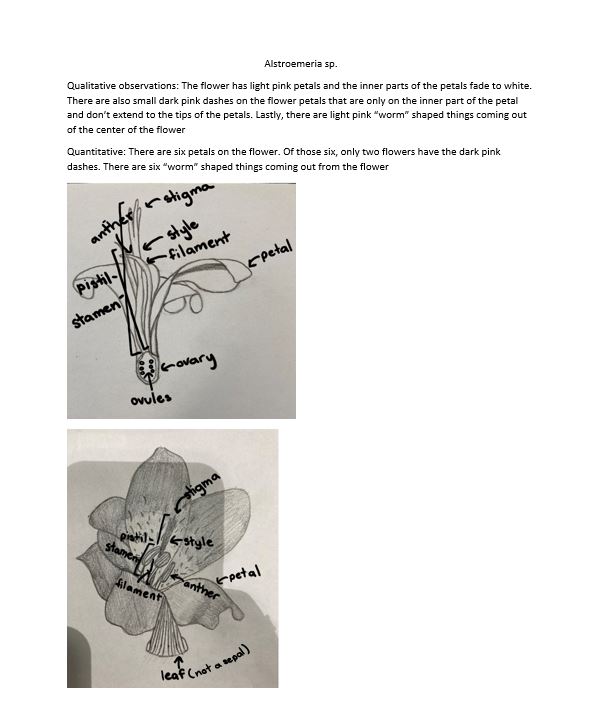
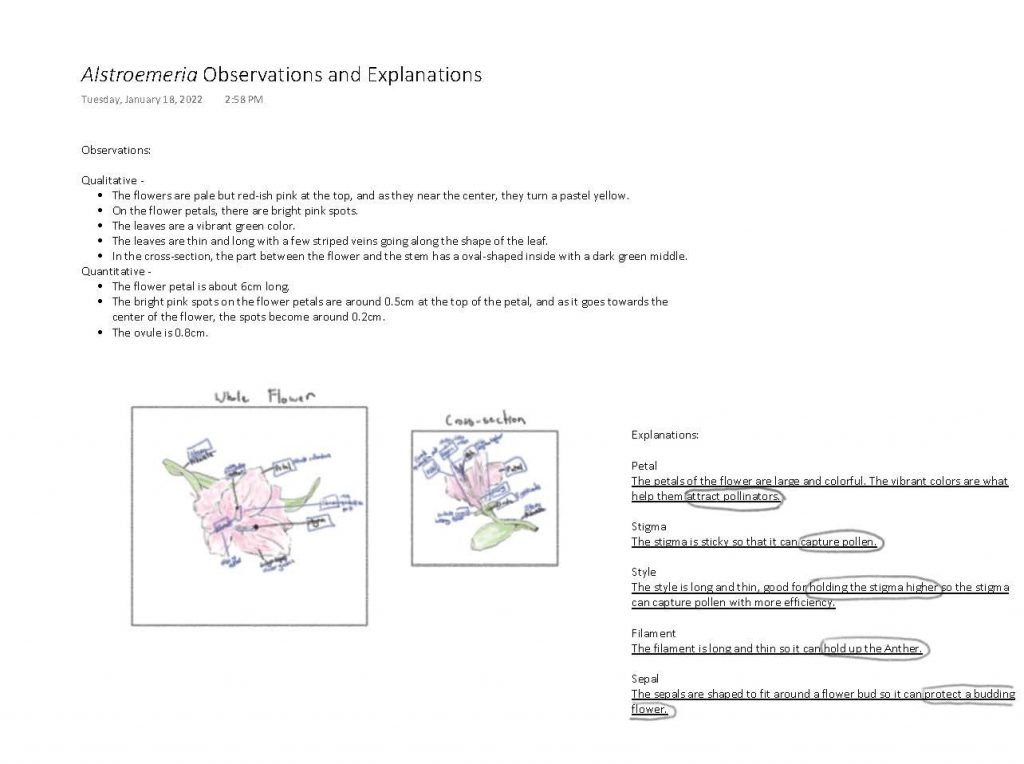
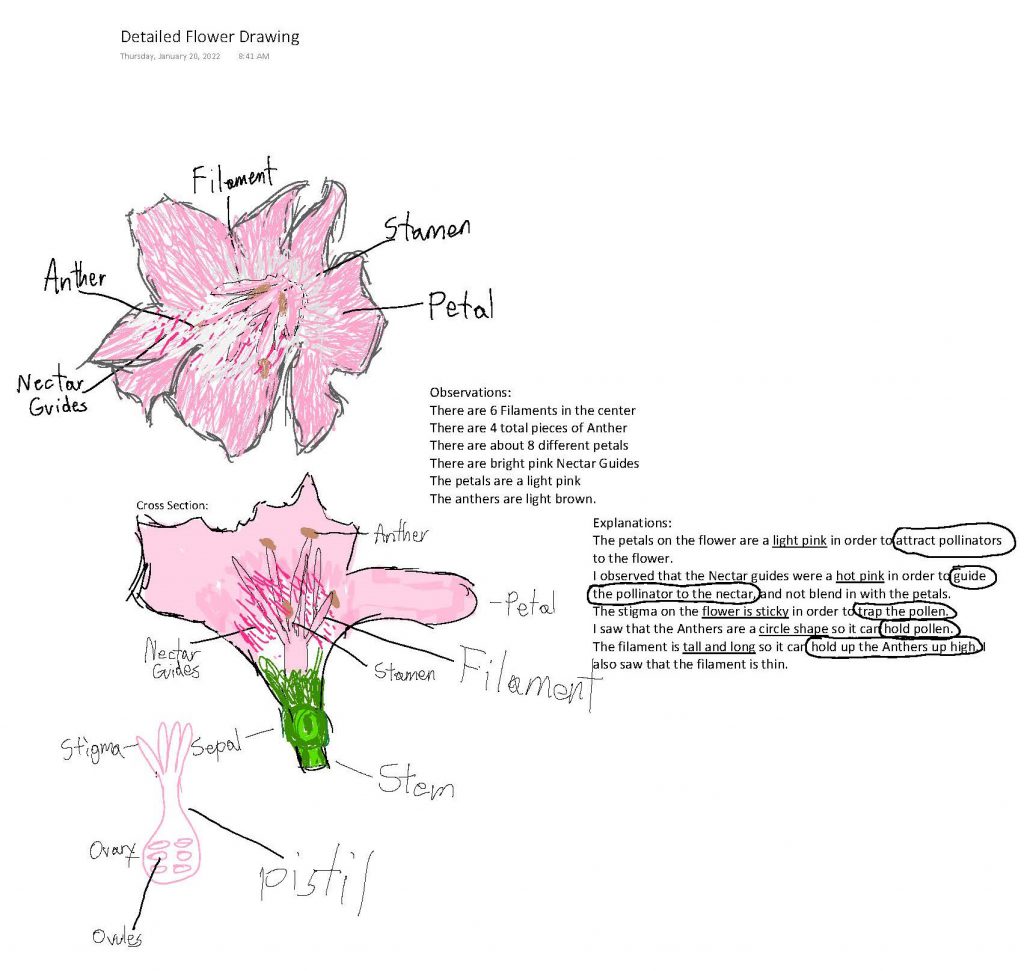
The lesson then builds to connect to themes of adaptation and evolution by examining the relationships between flowers and pollinators, and I have found that students have a much stronger understanding of the structure and function of the flower parts via this approach. This culminates in a Flower Discovery Project, where they “discover” a new species of flower and infer its pollinator based on the anatomy and habitat of their new flowers.
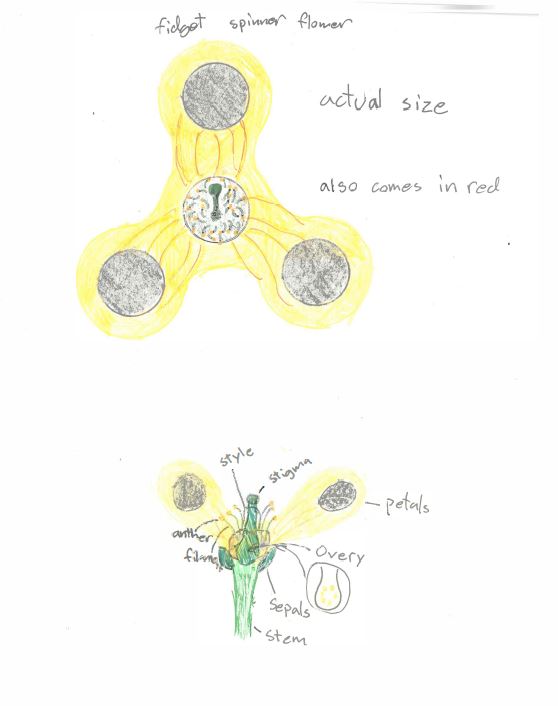
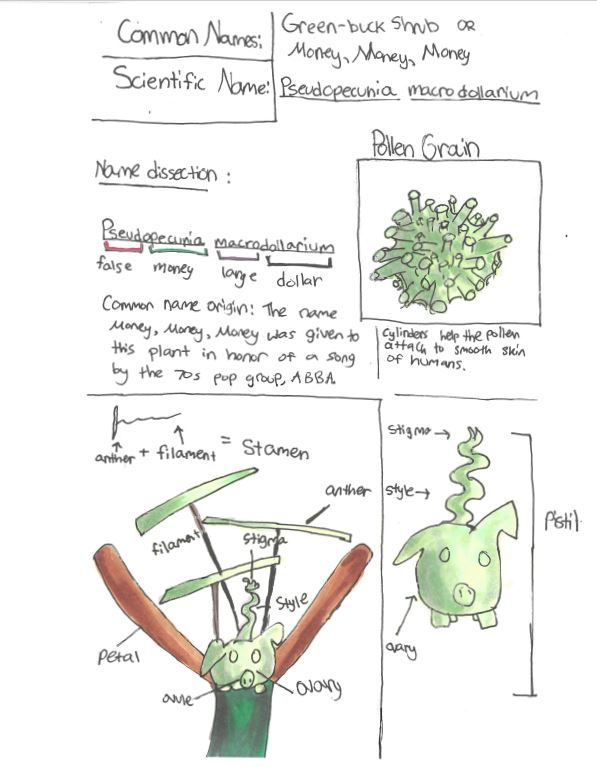
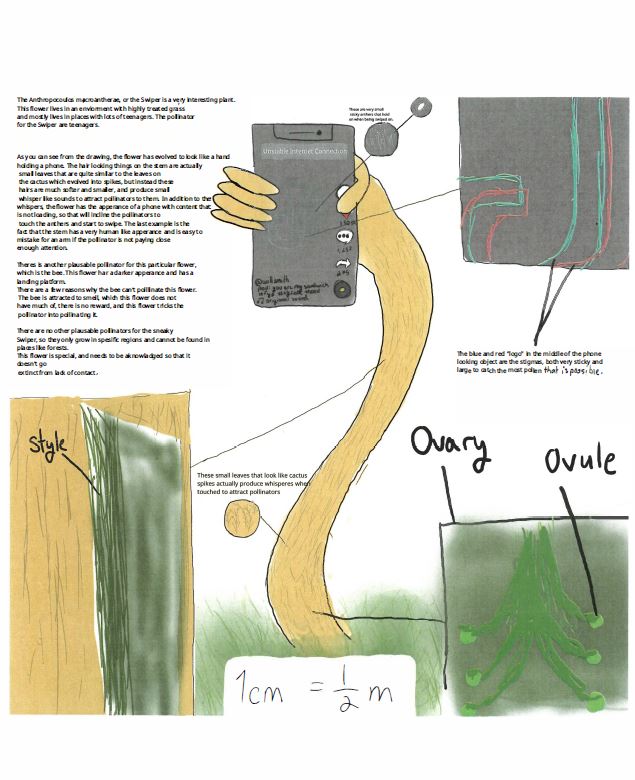
Integration is the area that feels that it has the most room for growth in terms of my classes, at least on a large scale. There never seems to be enough time to integrate in a meaningful way with other classes that students are taking.
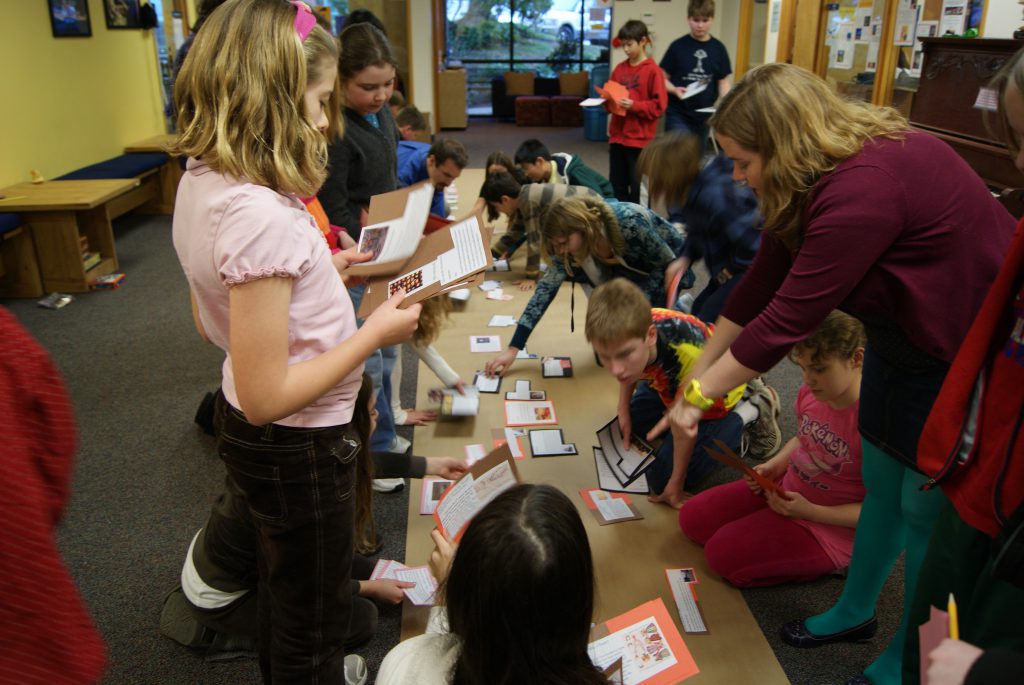
The seemingly obvious option would be to connect to math classes, but the different math levels in each class makes this a challenge to incorporate. Additionally, a lot of the content I teach is less quantitative than some other areas of science, so we’re just not working with specific numbers all that often. In past years, Adam Waltzer’s Advanced Bio students have occasionally worked with my Scientific Thinking 2 students when we study human systems. The Advanced Bio students have used 7th graders as subjects both for gathering data as well as for teaching opportunities. We haven’t done this in the past few years of remote/hybrid teaching but I hope that this is something that we’ll incorporate again as we move forward.
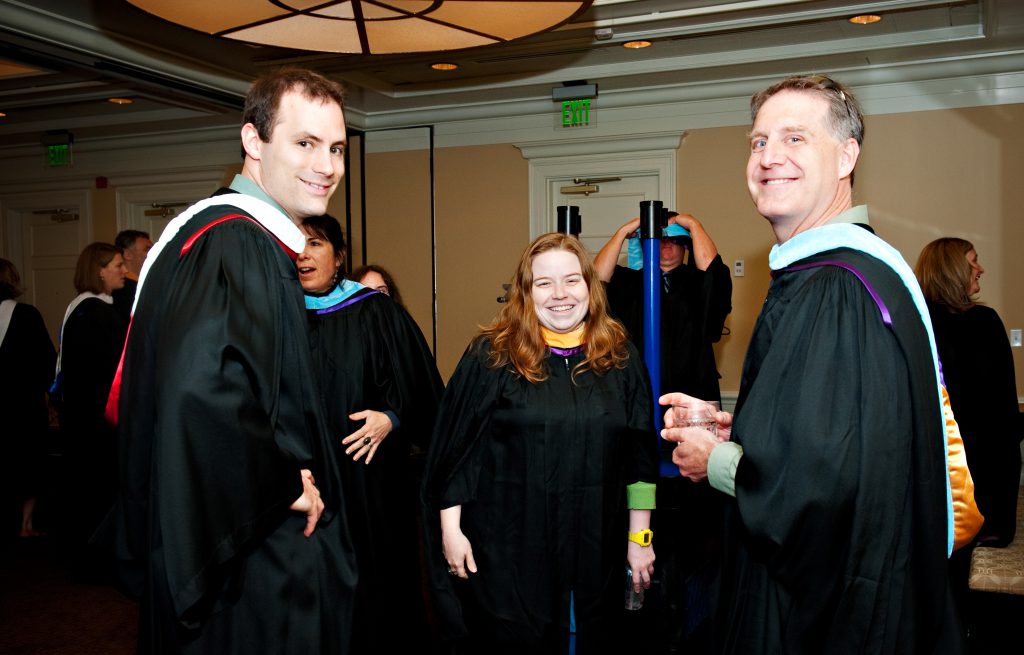
(3) collaboratively designs and evolves course curricula that are reflective of their academic discipline’s philosophy and derivative of the school’s overarching philosophy
I was the Science Discipline representative in the 2018-2019 and 2019-2020 school years.
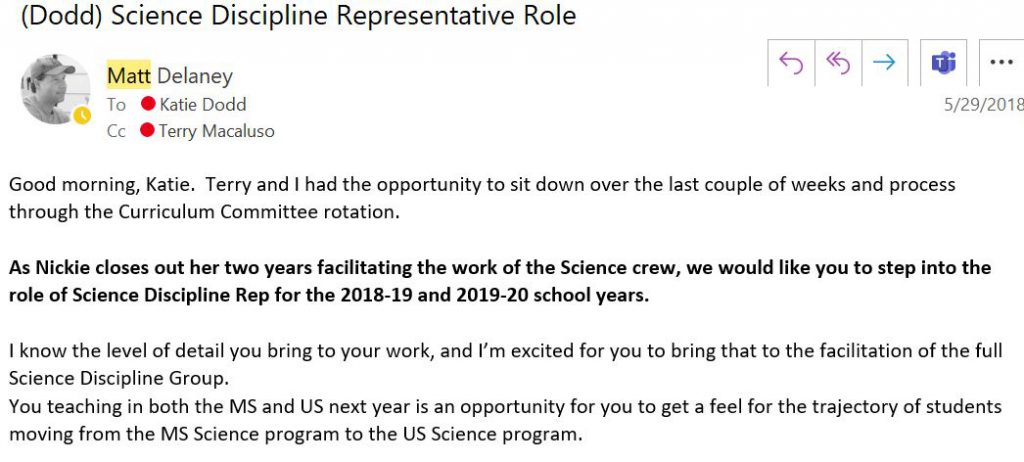
At that time, the role was different from its current iteration as part of the Academic Design Group, and had fewer specific duties as they were spread out among different members of the discipline. In this role I was primarily responsible for coordinating our discipline time and meeting occasionally with the Academic Dean to discuss the discipline as a whole.
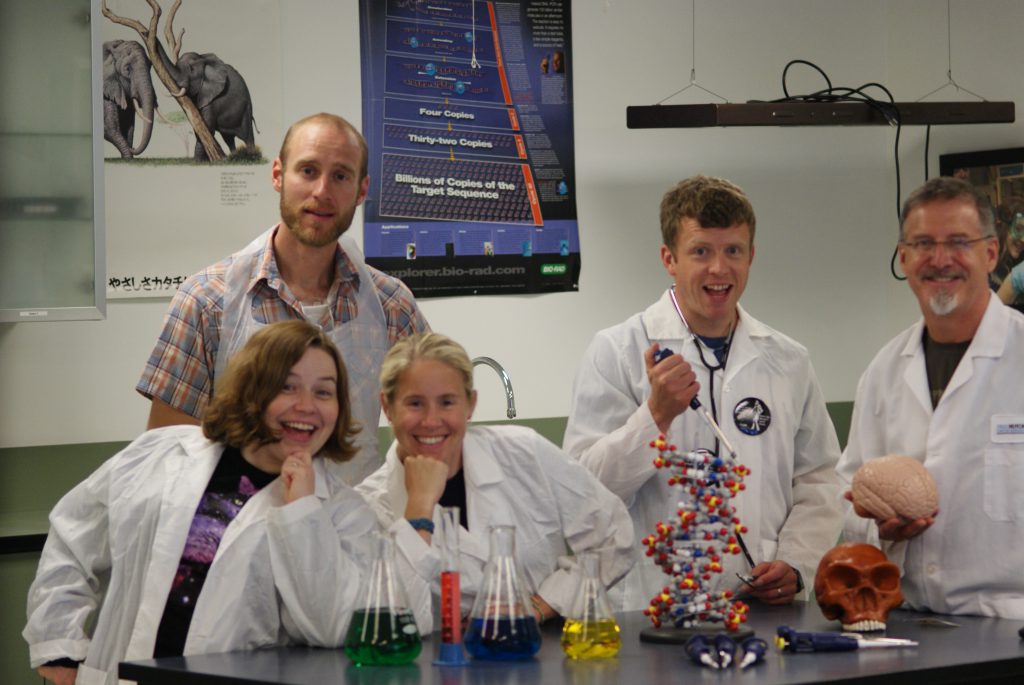
The Science Discipline’s philosophy statement is as follows:
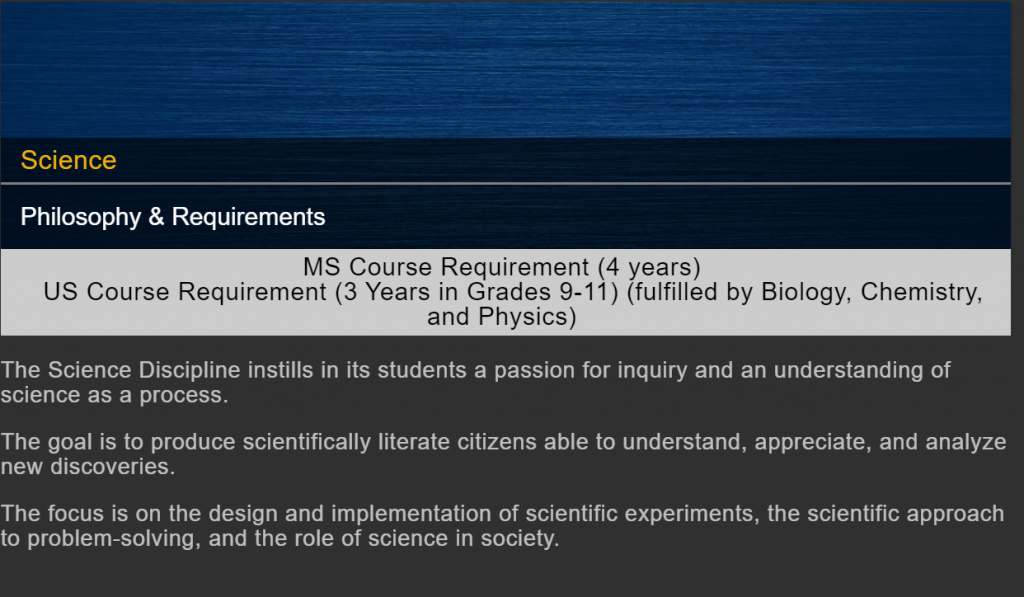
One of the key ideas to me here is the emphasis on process–that science is never “done,” and that we don’t have a “book of answers” that lets us look things up to learn anything we want about the universe. Instead, it’s a constant process of asking questions, devising ways to gather data that can help answer those questions, and reflecting on the larger context. I have a lesson early in the year in the 7th grade that helps bring this point home to students. I have a large Petri dish filled with water set up under the document camera. I dim the lights in the room and project the feed onto the board. I tell students that they will be allowed to briefly see a “Mystery Object” and they need to record observations that lead them to believe it is a living thing. Then I use an eye dropper to release a mystery object into the dish and let them view it for a brief period–no more than 30 seconds.
They share with each other what leads them to believe it’s living and what makes them think it’s not living, and this connects us to the larger topic of characteristics of living things. What many of them find infuriating, though, is that I don’t tell them at the end of the lesson whether or not what they saw was alive. Instead, I say that in science in the real world we don’t have an answer key that we can check and that we must draw conclusions based on the evidence we have available to us. I mollify them a bit by promising to tell them what the mystery object was after they have graduated (“From high school??” they exclaim), and have been tickled by the fact that each year there are some students who come up to me after Commencement to ask about it.
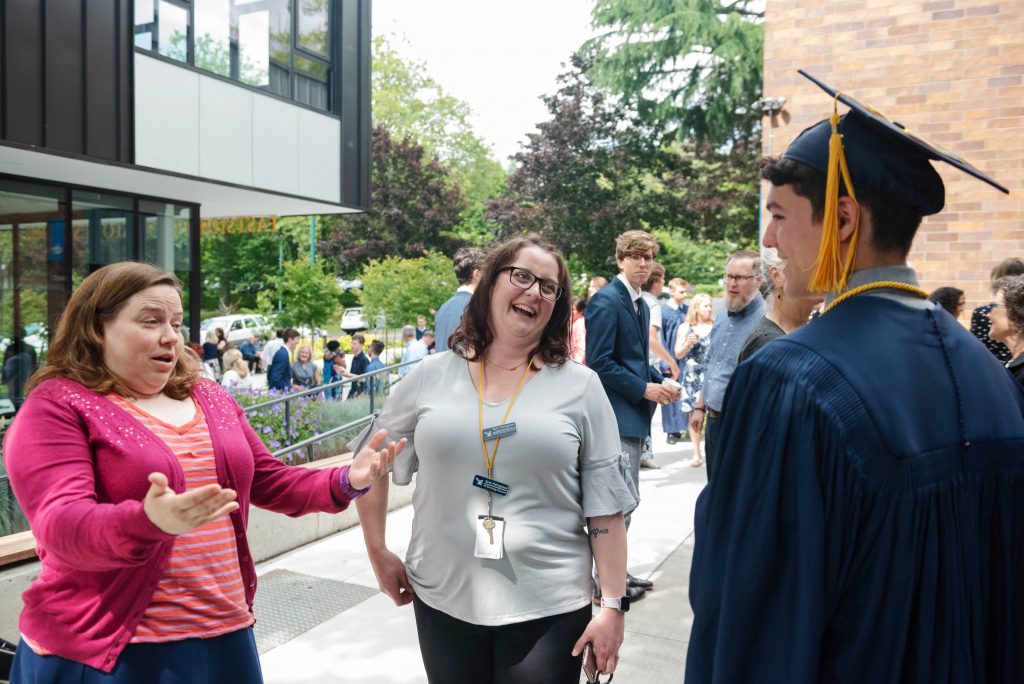
Throughout our courses in the Science discipline we consider the process of science and use this to inform our lessons and activities. As mentioned in the first indicator for this category, students build skills in a variety of areas, including understanding what constitutes a “scientific” question, writing hypotheses, graphing and analyzing data, and drawing conclusions. At various times throughout my time at EPS the science teachers have talked through the progression of expectations in our courses, and how we are supporting and challenging our students appropriate to their abilities at each level, although this is a conversation that should probably happen again soon as we have added new teachers since the last time. Those conversations happen more frequently between closely connected grades. For example, I have communicated with Krissy to understand what she’s asked of her 6th graders (since that class has changed since I taught it), and have also talked with Burton about what he can expect his 8th graders to have done prior to arriving in his classroom.
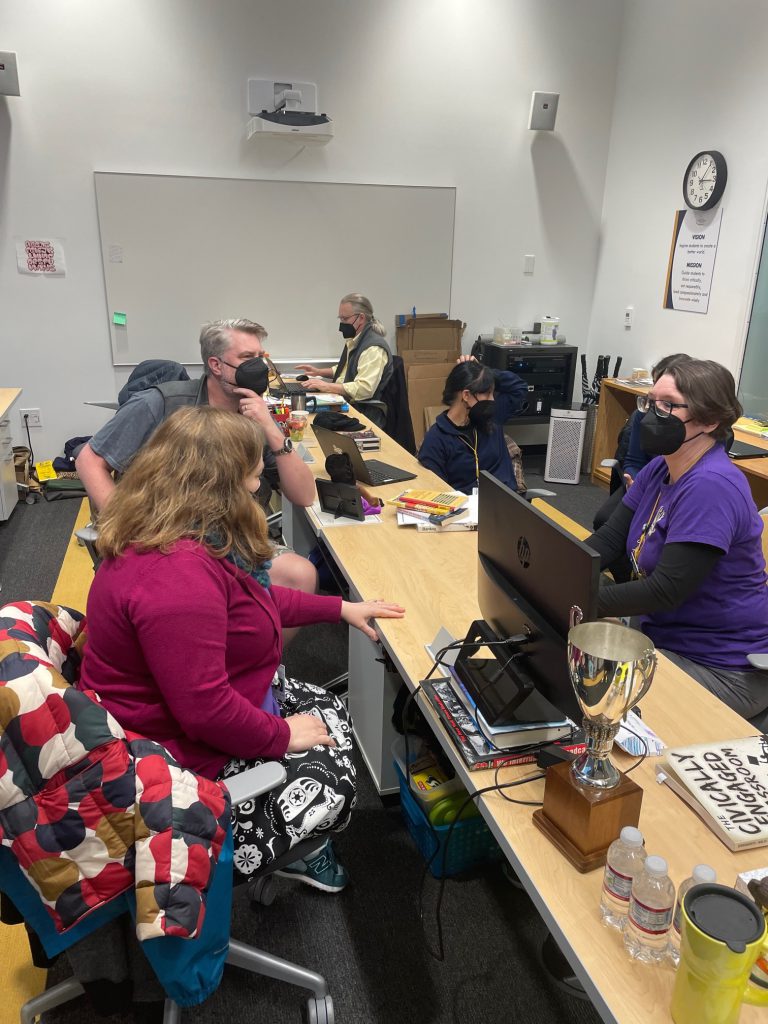
Thinking about this in relationship to the school’s vision and mission, once again there are many opportunities for these to align. The idea of inspiring students to create a better world comes through in our discussions of sustainability and climate change (most acutely in the US Ecology class). Critical thinking is the goal across all classes, with students frequently asked to answer based on their current understanding of topics, and then opportunities are provided to expand upon or revise that thinking.
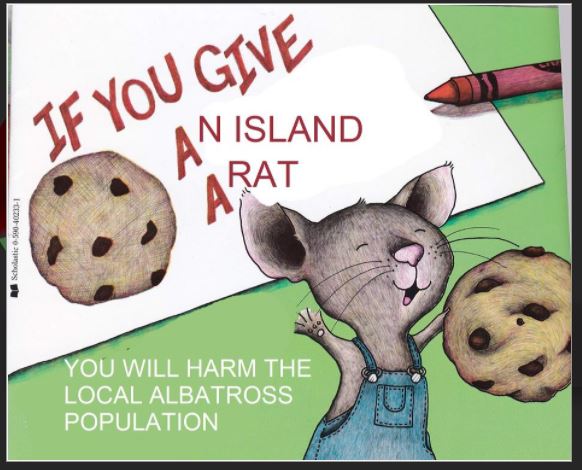
Open-ended questions that don’t have “right” answers allow students to ponder topics rather than rushing to the “correct” answer. I also would say that many of EPS’s mission statements are reflected not only in my course content, but also in classroom expectations. In my early days of teaching I had a participation grade, but renamed it “Responsible Action” to help connect it to the school’s mission. To that end, students in Scientific Thinking 2 have 20% of their overall grade allotted to that category, and it is broken down for them in terms of various actions that are, indeed, responsible (see rubric).
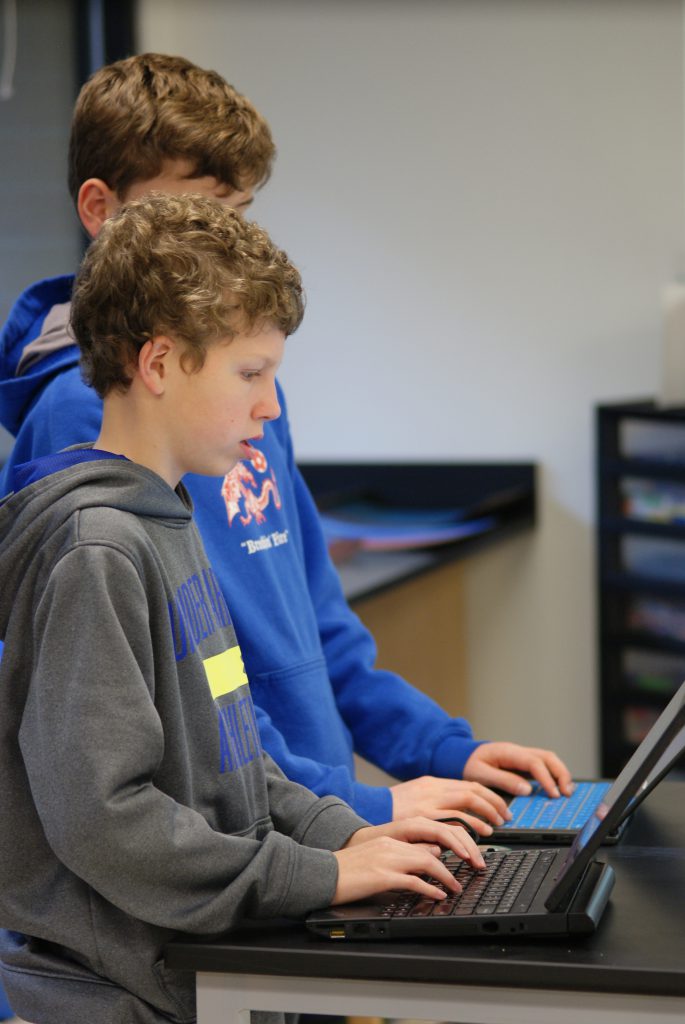
Compassionate leadership comes through (in just one example) during our conversations about gender and identity, and the importance of respecting everyone’s identity, even when our values may differ. Finally, over the years I would say that I have “innovated wisely” in terms of how some tech has been used in my lessons. For example, students now submit a Flipgrid video of their cell analogy project rather than bringing the entire model in (although they are also encouraged to do that, if they’d like).
Beyond the points of the mission, though, is a broader idea of connecting my classes with a philosophy of belonging and inclusion. After all, to do your best work you need to feel like you belong, so my curriculum has been adapted over the years to hopefully help kids see more of themselves. One specific example of this are the changes in the way that sex ed has been taught to the 7th graders. I’ve spoken about it a bit already in the Relational Cultivation domain, but to summarize some points here, this content was taught as a binary for many years, with different supplemental texts for “male” and “female” students. Although the content was always taught to the full class, there were also times when students were split into “boy” and “girl” groups to have ostensibly single-gender conversations. I discontinued both of these practices several years ago after recognizing that they weren’t representative of our student population (or the world at large).
“[Katie has] worked hard to revamp her 7th grade science curriculum to serve all students, regardless of gender identity. The anonymous question box springs to mind–Katie was ready to shift from a gender binary anonymous gender box answer session to one that was not separated in this way.”
–Bess McKinney
The past two years in particular we have spent more time on gender and identity in this curriculum, helping students with the concepts and language associated with these topics. We explicitly discuss how biological sex has different components (including chromosomes, anatomy, sex hormones, etc.) and that even among these things are not as binary as they were once believed (we talk about what it means to be intersex). I know that we have more students who identify as transgender or non-binary, and I hope that this helps them feel more seen and supported in the science classroom.
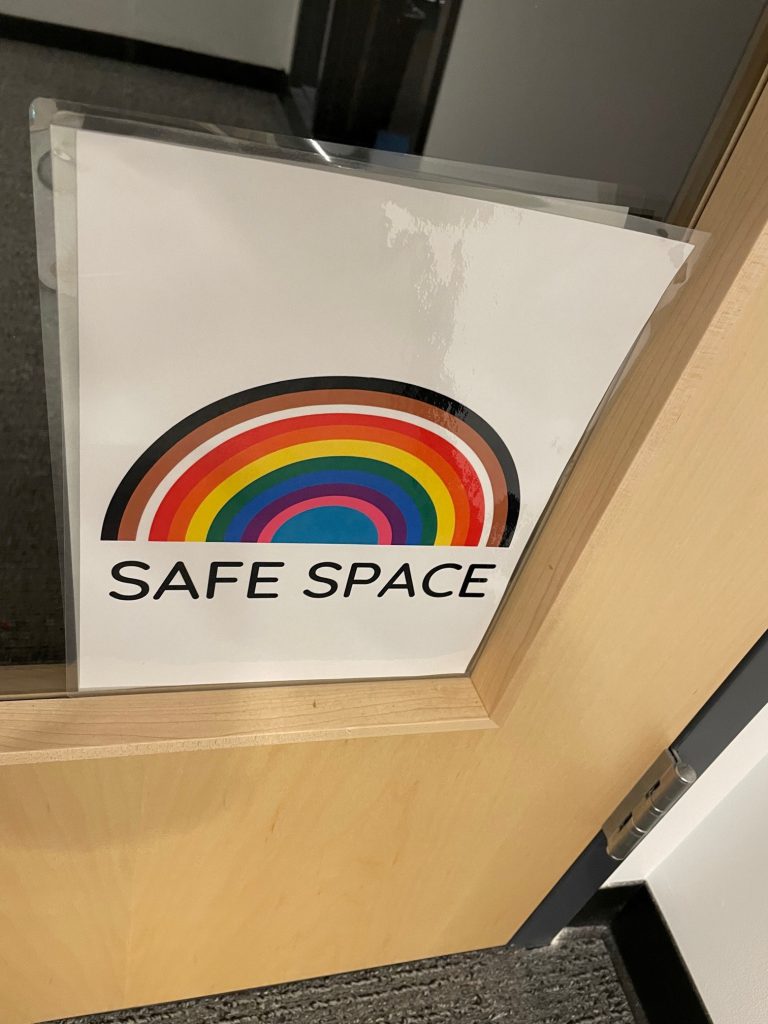
I’m also very careful about binary language in teaching genetics or reproductive anatomy, referring to “bodies with ovaries” or “bodies with testicles” instead of “girls” and “boys.” As I have made these changes, I have been in conversation with Bess McKinney in her role as an EICL coordinator to help guide me, and I have been very grateful this year to start talking with Sam Foote, one of our counselors, who is very interested in this content and has kindly agreed to share their perspective.
” I have observed Katie recognizing and supporting diversity in her curriculum with regard to the LGBTQ+ community during her science units on adolescent and sexual health education.”
–Elin Kuffner
I also want all students to see themselves as scientists and work to try to break down some of the stereotypes in these areas (although this is an area where there is continuing work to be done). I think it’s important to model being a woman in science, and (when appropriate) mention my background as a scientist prior to becoming a teacher. This was something that I think I was subconsciously aware of in my early years of teaching but it came more to the forefront when I got a note from the mother of Sophia Maymudes, who was in the very first 6th grade class that I taught at EPS. Emily (her mom) wrote me a “Kind Card,” thanking me for being a role model of a woman in science to her daughter.
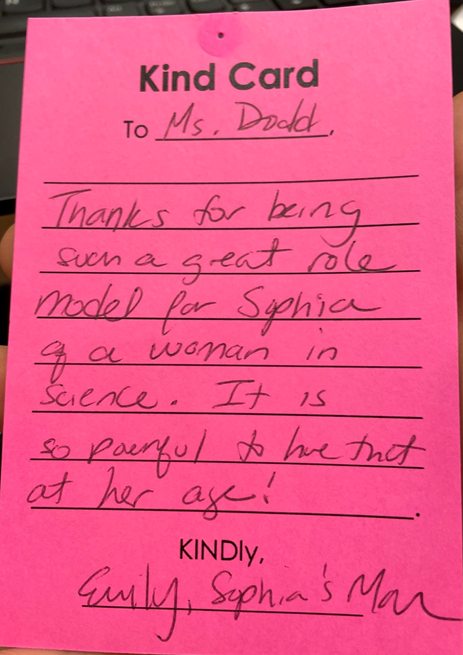
I was really touched by this and it’s been in the back of my mind as a responsibility since then.
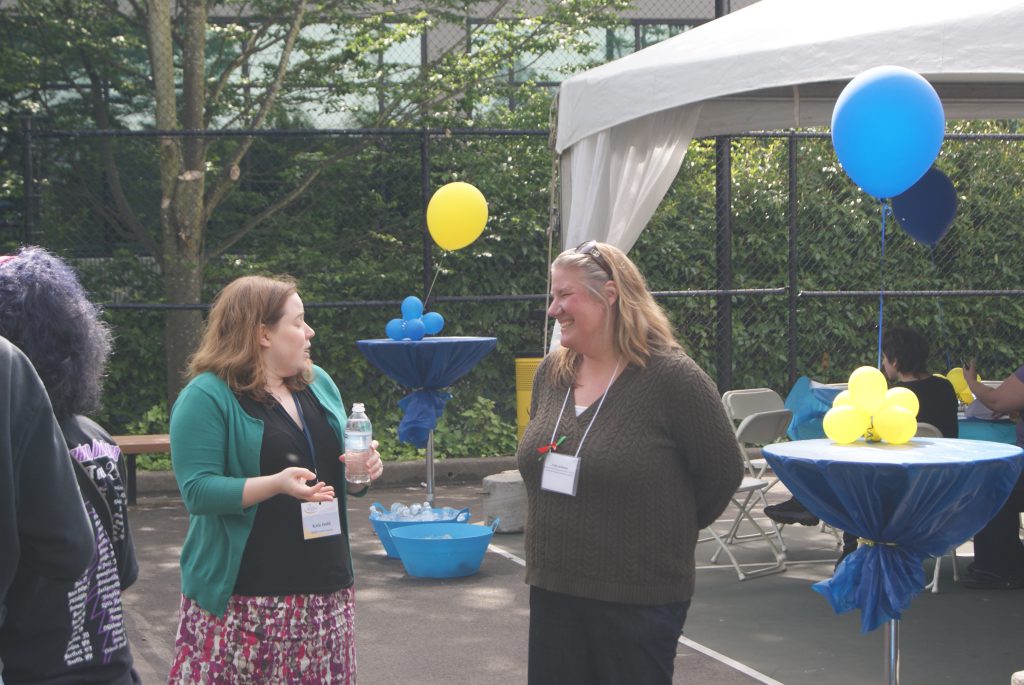
I’ve also considered that as part of my role as an Upper School science teacher, in that Anne Duffy is currently the only other female-identifying person teaching US science classes at EPS.
The last piece I’d like to touch on here is the value of collaboration, which I think is also something that is “baked in” to the schoolwide philosophy. This is something that happens frequently in Science classes, with students typically working in pairs or groups of three to gather data and conduct experiments. Some people have this stereotype of a solitary scientist working in a lab, but the reality is that nearly all science that takes place in “the real world” is a collaboration, with many people working together to build our collective knowledge.
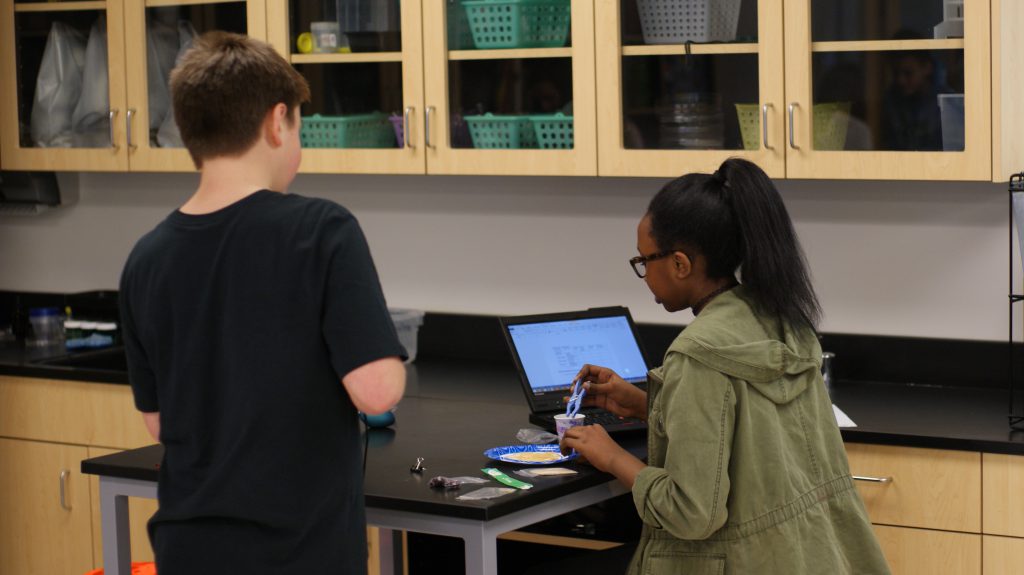
Having a chance to practice this in a classroom setting not only gives students opportunities to feel a sense of collaboration, but also to push through and find a resolution in those times when the collaboration might feel challenging.

(4) updates course content to reflect the contemporary world
The most obvious example of this indicator are the changes I made to how I teach the immune system to 7th graders. Prior to 2020, the topic was taught more generally, with occasional focus on topics in the news (such as periodic measles outbursts). That all changed when we went home in March 2020 and began teaching remotely. By sheer coincidence, the very next topic that I would be covering with my Scientific Thinking 2 class was the immune system. I pivoted to channel most of this curriculum to focus on what was currently known about COVID-19, providing students with many more opportunities to ask random questions and (hopefully) help them feel a little more confident in their understanding of the pandemic that we were just starting to navigate. There couldn’t be more real-world relevance for course content, and student engagement felt pretty high, especially given the challenges of the new-to-us remote interface.
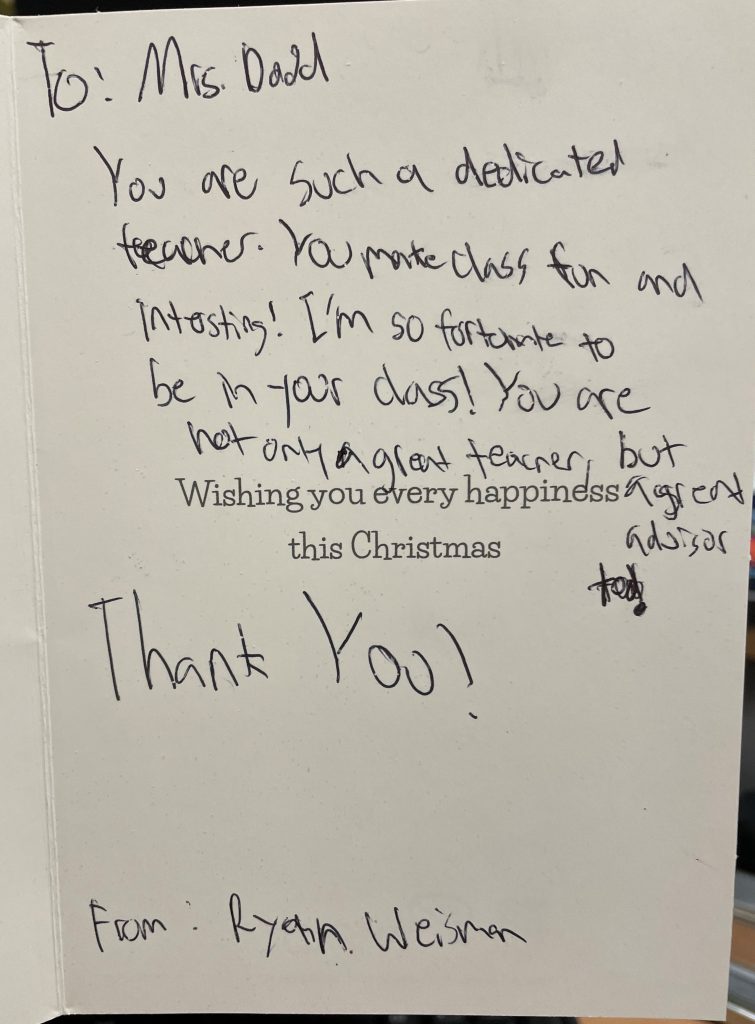
Prior to Spring 2021, I participated in several professional development opportunities that allowed me to further build my knowledge, so I was able to tie even more of the immune system curriculum to COVID-19, particularly in discussing the details of how new viruses arise as well as how vaccines work (and are developed). I revised the content once again in spring of 2022 to be sure that I had the most up-to-date information on the pandemic.
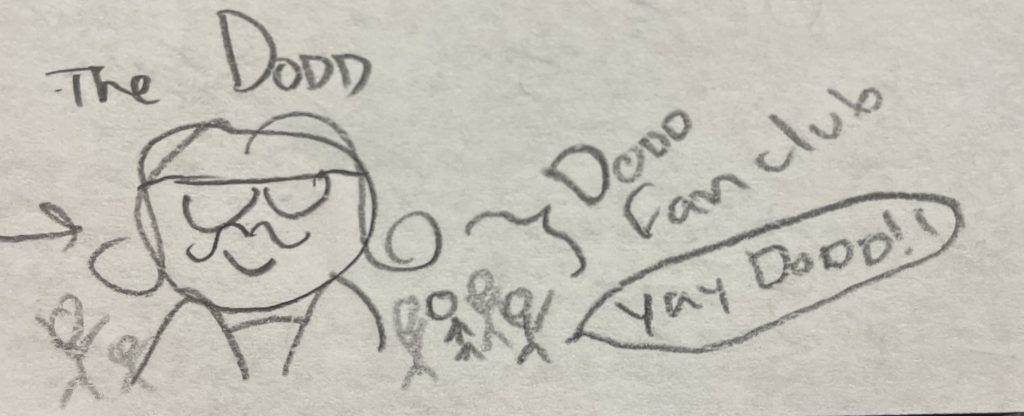
In the US Ecology course, I have been working to increase connections to the contemporary world. The first year I taught the class I was very proud of myself for including a connection to climate change in the long-term experiments that students designed. I realized after the fact that this basically just led to a bunch of experiments where students either increased the heat or decreased the watering of plants, and things became a bit one-note. I removed that parameter in the next iteration and saw a greater variety of projects (many of which did still connect to themes of climate change).
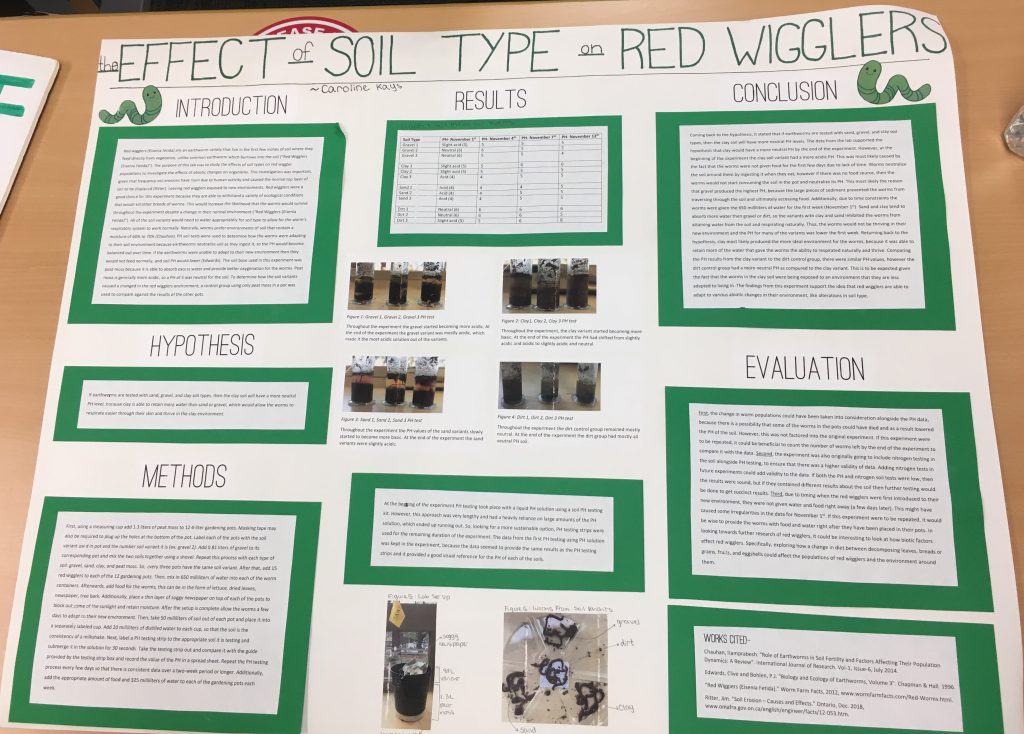
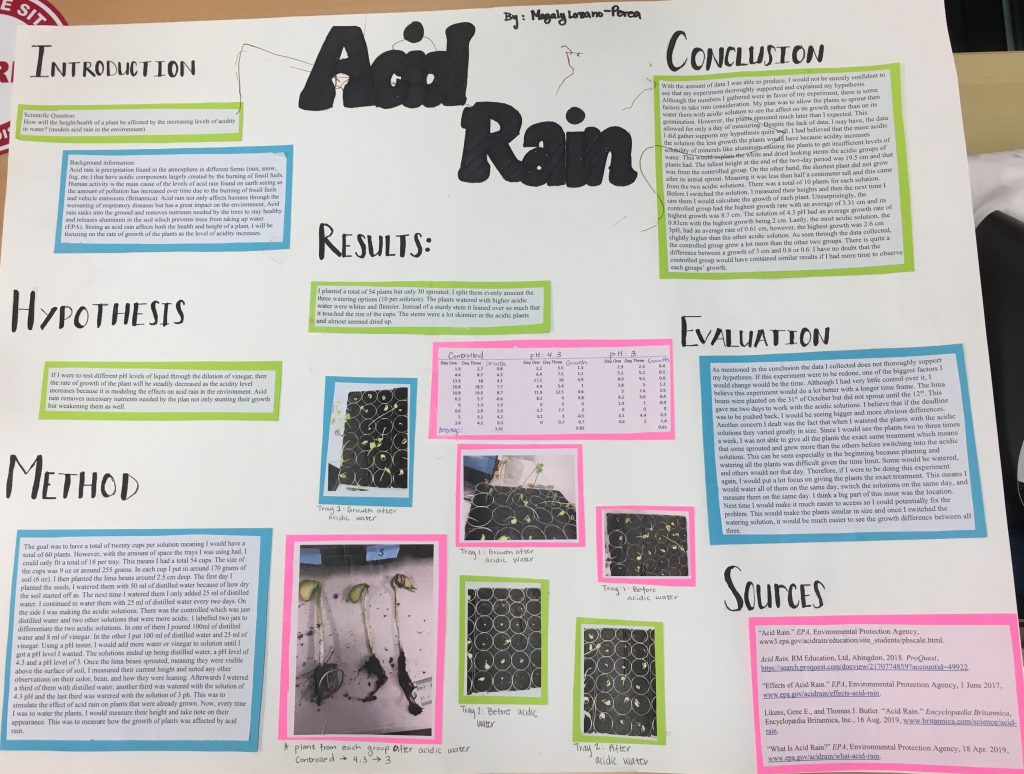
At the end of the trimester in Ecology we have a Tela discussion with the following prompt: “How sustainable is human life on this planet, and what, if anything, should we do about it?” As part of their preparation, students had to find recent articles connected to this topic, and take notes on their article as well as those of two of their classmates. I’ve been really proud each time of the conversations that these Upper School students have. They are really clear-eyed about many of the environmental challenges facing the planet, but they approach them with determination and optimism. It makes me hopeful that they will find ways to turn the tide on many of these issues, which they will be inheriting from prior generations.
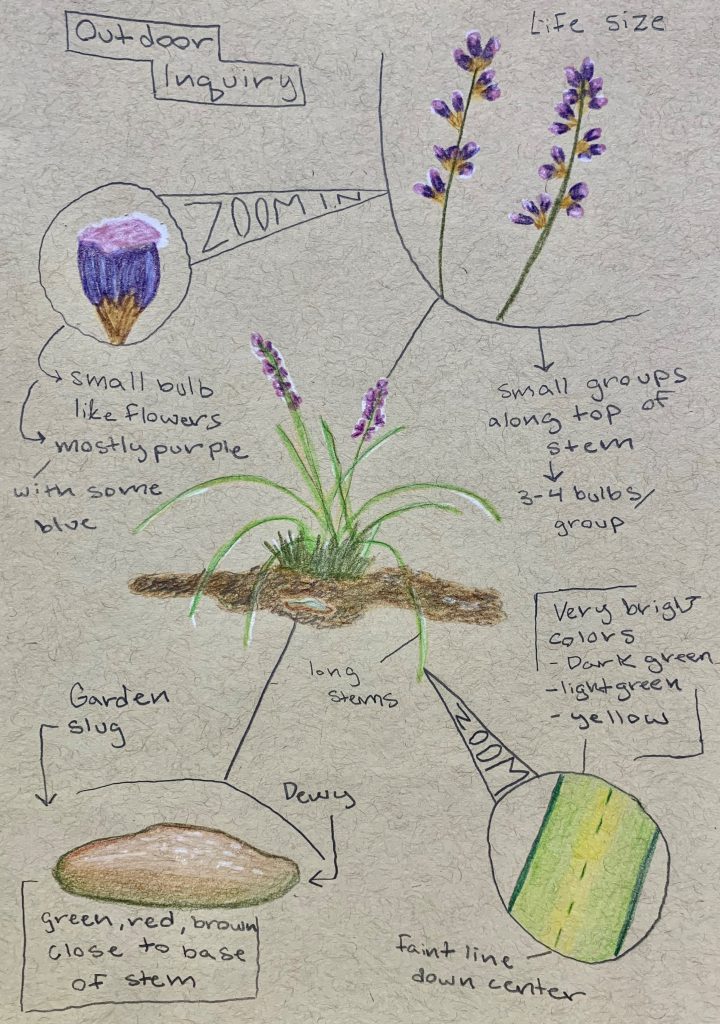
I am still working on ways to address topics connected to issues of inequity in my classes. As mentioned elsewhere in this PDP, as a small measure, I’ve added content that connects the impacts of climate change with racial disparities so that students can start to think about how these challenges don’t impact all people equally. In the 7th grade I used to teach a lesson on “the Genetics of Harry Potter,” but haven’t felt comfortable with that the past couple of years given J.K. Rowling’s current stance on sex and gender. Given the challenges already faced by transgender and nonbinary individuals, I don’t want to give even the impression that I am in alignment with her statements. I haven’t found a great replacement, though, that pulls students in through that pop culture connection, so this is another thing that I am continuing to work on.
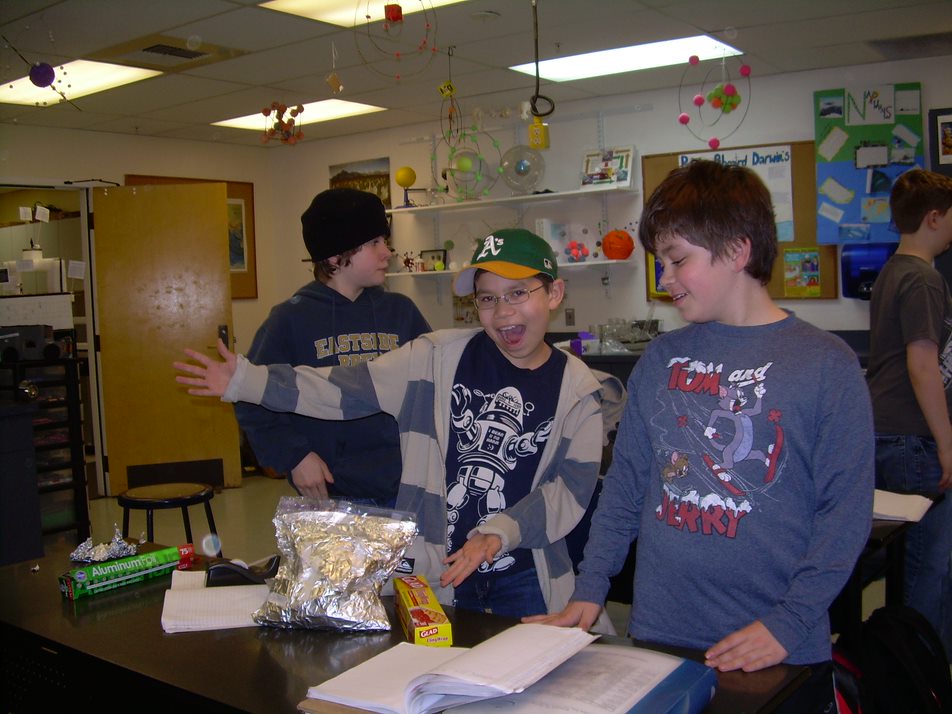
Program | Professional Development
Much of the way that I think about Program and Professional Development comes through the lens of improvement. How can I make myself better as a teacher (and, quite frankly, as a person)? How can our program at EPS improve to better serve all of our students?
I think about this in the context of the classroom as well as the advising program, and among the adult community as well. To that end, I look for professional development opportunities that feel connected to these goals.
“Working with Katie in many different arenas from teaching, advising, chaperoning and the heads search, Katie is a well respected member of the EPS community. She is constantly looking for ways to improve students experiences while thoughtfully and respectfully bringing up issues that are important and need attention.”
–Mike Anderson
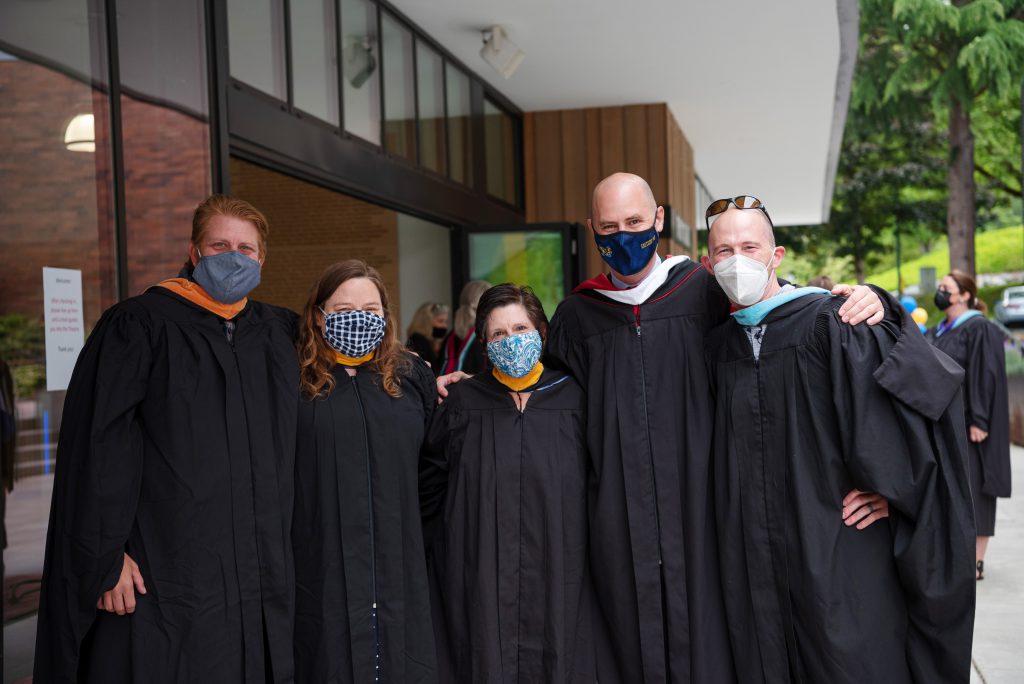
(1) participates actively and constructively in Program Development Day activities
I’m going to approach this indicator more broadly to include faculty and discipline meetings instead of limiting my response to only Program Development Days, as I don’t see a significant distinction between these in terms of the importance of active participation and engagement for faculty.
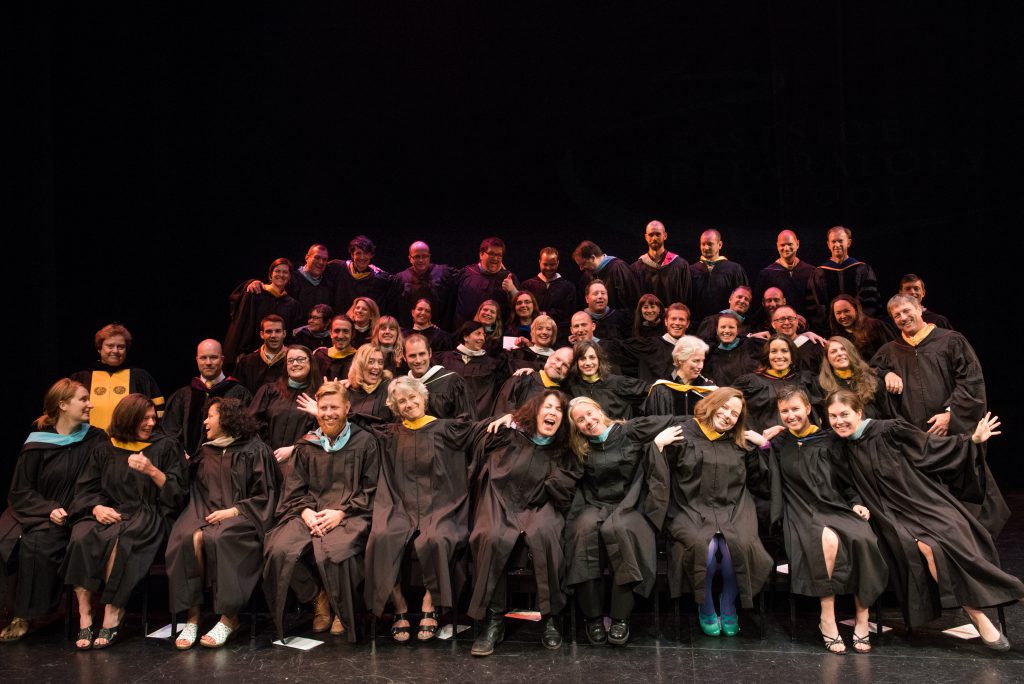
In these instances, I make an effort to engage in the presentations or conversations. To that end, I typically don’t bring my computer to meetings during Program Development Days, or at least, I don’t have it open, as I know that it will ultimately distract me. I am also diligent about doing the summer reading (most summers I tend to read several of the selected texts, although this varies depending on availability of books as well as the specific topics and whether or not they are compelling to me). To that end, I have stepped up and served as a leader for reading groups on occasion.
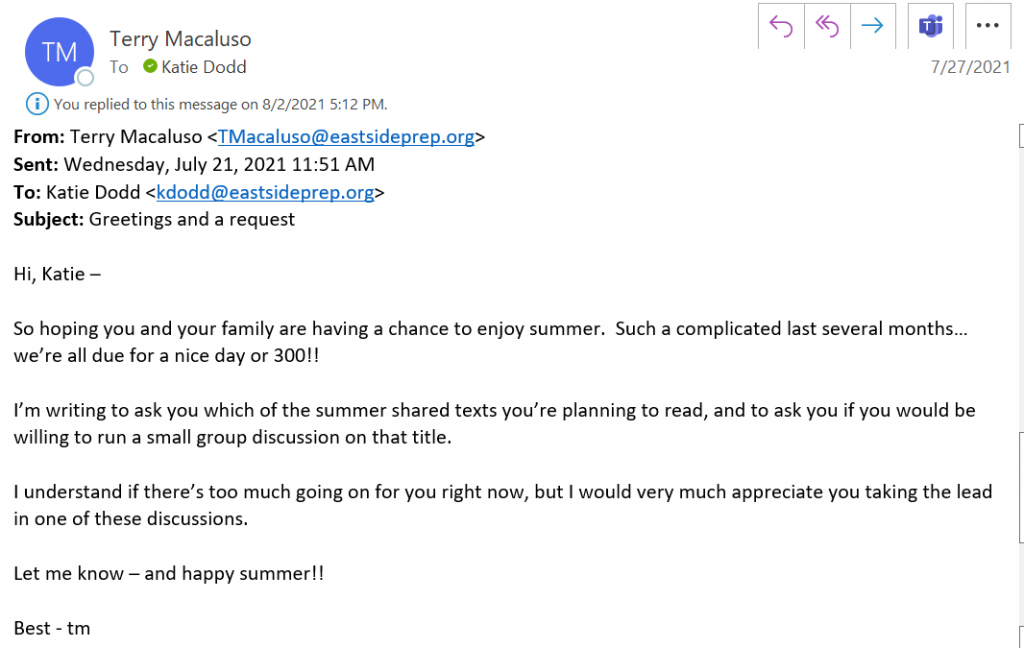
It’s been interesting over the years to consider how my sense of my responsibility in these kinds of conversations has changed. I have often been self-conscious about contributing TOO frequently, and so I have tried to hold back to make space for other voices to be heard.
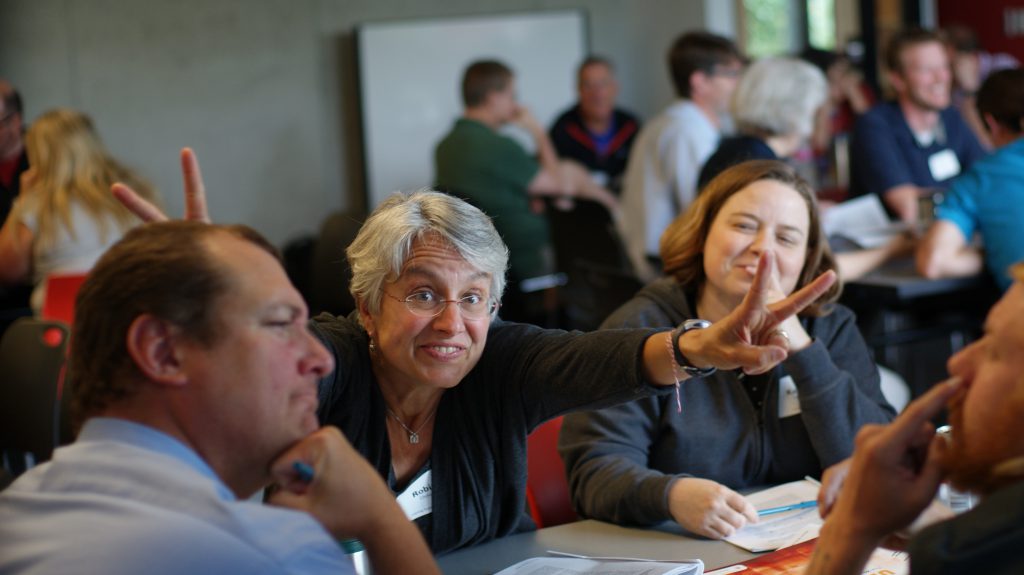
This is not always easy for me, as I love to share my opinion (just ask my office mates!), but it is something I think about. My peers have been really kind about my role in this respect.
“You are a great person to bounce ideas off – pedagogical, philosophical, and scientific. I appreciated the time you take to ask questions as well as listen to questions being asked – you give thoughtful, honest answers. You are also detail oriented and not afraid to point out oversights and mistakes – we joke with you in division meetings, but we rely on you to speak your mind and point out errors…ideas have to pass the Dodd Test!”
–Burton Barrager
At the same time, as I have been a member of this community for a long time, I feel that I have a responsibility to speak up if there are things that I don’t understand or don’t agree with.
“Katie often speaks up during faculty/staff meetings when others do not feel comfortable.”
–Elin Kuffner
One example that stands out to me in this respect was during a meeting when we were remote. We started with a check-in where people shared how they were feeling, on a scale of 1-10. As someone who was struggling with many aspects of remote work (plus the whole pandemic situation), I was surprised at how many people in the group said they were an 8 or 9, and just the overall chipper tone of much of what was being shared. While it is of course true that this could be the experience of others, I also felt it was important to show that it was okay NOT to be okay, and shared that I was currently at a 3.
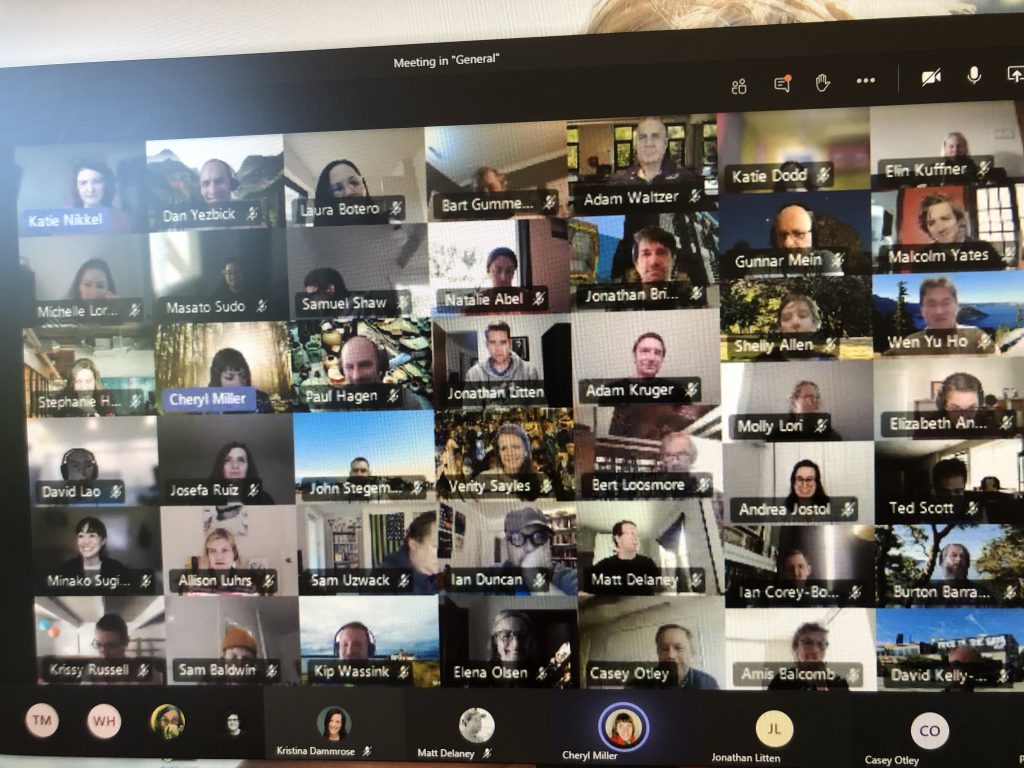
It’s my hope that by doing so I created a little space and gave others permission that not everyone has to be feeling great all of the time. I try to think about it from the perspective of someone who is newer to our community, and may feel more vulnerable in these moments. And to that end, I have had several people approach me after meetings to express their appreciation for my comment or question, which helps me see the value in this practice.

I’m typically a little more vocal in smaller group settings, whether that’s in a Science discipline meeting or a Middle School faculty meeting. There is still that push and pull about not wanting to dominate things while also wanting to share my thoughts on the topic at hand.
“Katie is a wonderful colleague. She has deep bonds with veteran faculty, but also looks after new folks. She mentors new teachers. She is also a respected voice in our faculty meetings, and will lead conversations form time to time as well.”
–Sam Uzwack
I also hope that any expression of frustration that I might have is understood to be coming from the perspective of wanting to enact positive changes within our school and community. It’s not about trying to be in the spotlight for my own sake–I have strong opinions about many of these topics because I want to help EPS become the best version of itself.
“Katie is always willing to ask the tough questions. She is always analyzing what possible problems can come out of a situation. This is very helpful in group discussions when a new program is being implemented. She will ask her colleagues the who/what/where/when/why questions that others might not think to ask. This is great way to get others thinking about how to solve problems. She always has great ideas.”
Randi Peterson
Along with that it’s important for me to remember that I don’t always have access to all of the information behind decisions, and so I try to find a balance (sometimes more successfully than others).
(2) presents during Program Development Days and conferences
I am taking a slightly wider view of this indicator and opening it up to the idea of sharing my expertise with the community in a variety of contexts.
“Katie’s community membership and opinions are so highly valued that she often is selected to be on multiple committees at once, from the admissions committee to the head of middle school search committee. And when Katie participates in all these endeavors, she does so with energy, enthusiasm, and passion.”
–Elin Kuffner
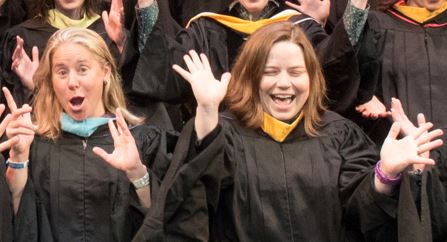
Despite Elin’s kind words above, I would say that I am not typically someone who is in the spotlight on Program Development Days specifically, at least in any sort of official sense. While I am open to authentic opportunities to contribute, I don’t need to be visible just for the sake of being visible. Some of this also stems from the fact that in many contexts I don’t think I have particularly groundbreaking ideas or innovative suggestions to share (such as during an Evo of Instruction session). I was thinking about this again recently when I realized that I fell neatly into the tail end of a graph that Briggs presented during an April 2022 Evo session.
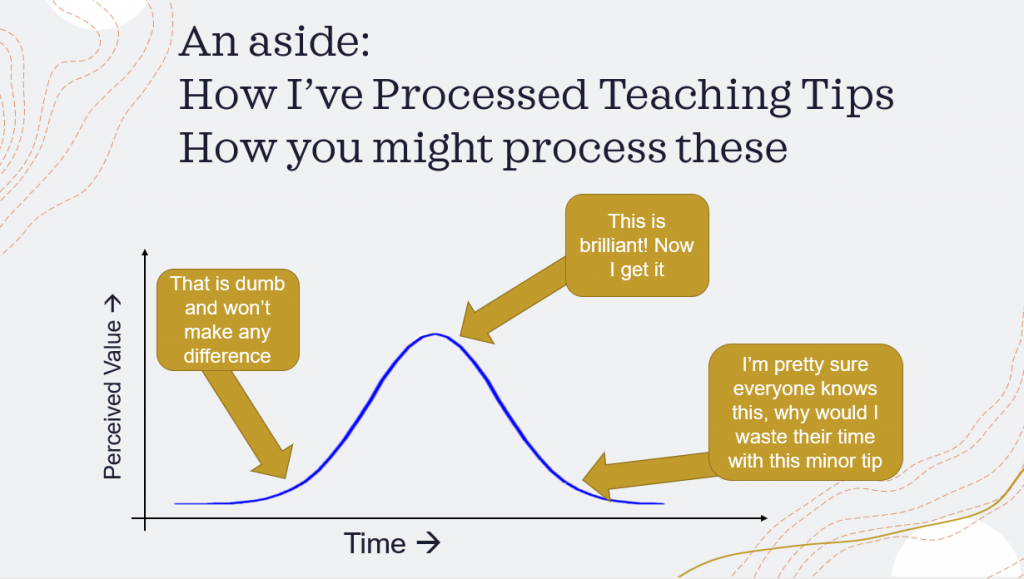
I identify as part of the group that don’t step up to share tips/techniques/strategies for exactly that reason: I don’t believe they would be valuable to my peers. That being said, I have stepped up in a couple of situations over my years at EPS. One of these was when I presented as part of the group of faculty who attended the Learning and the Brain conference in San Francisco in 2011. (see slides here). My part of the presentation focused on a few particular areas, including the importance of being safe to fail, how and why to assess for enduring understanding, as well as the impact of transitions in terms of the mental cost to students.
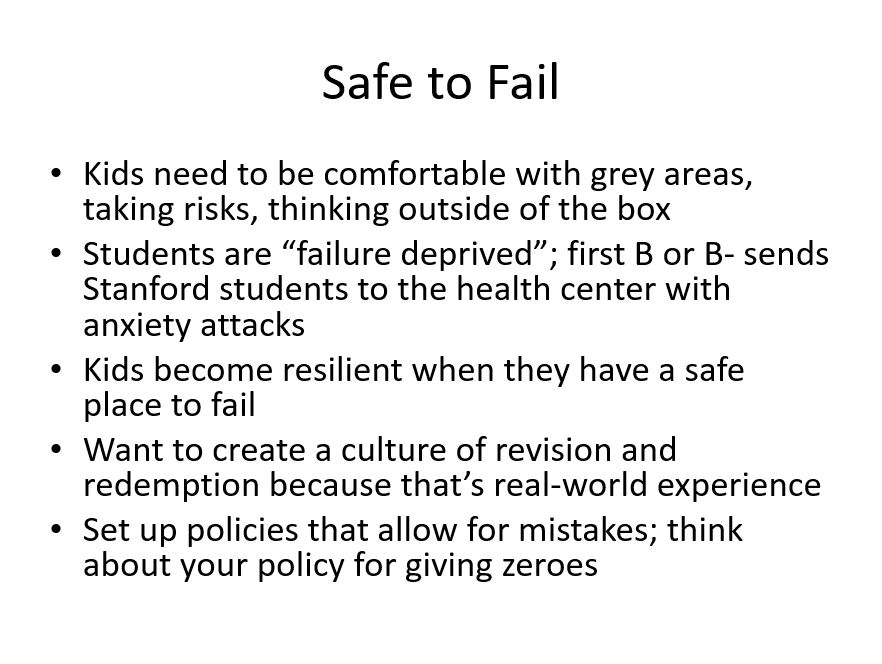
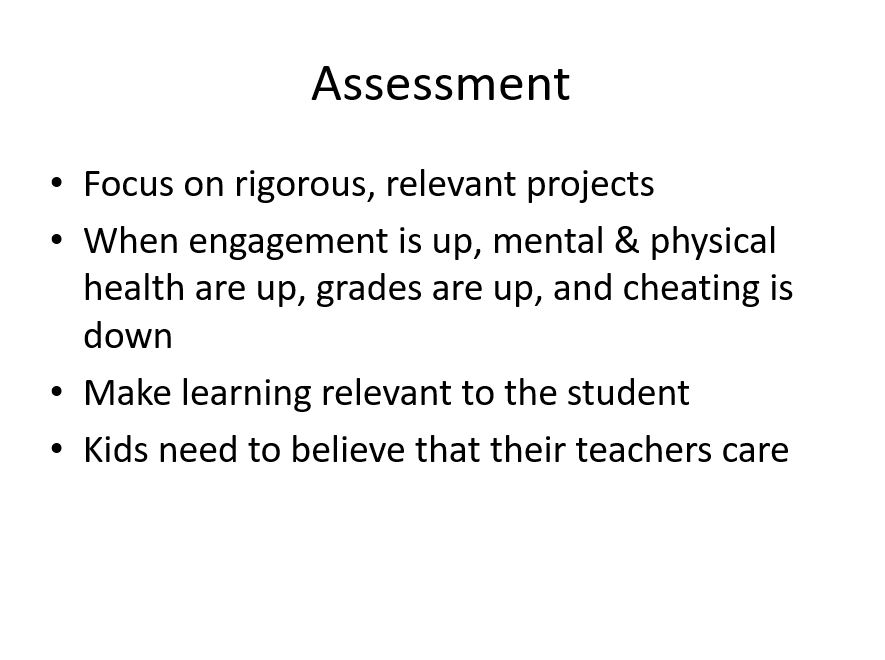
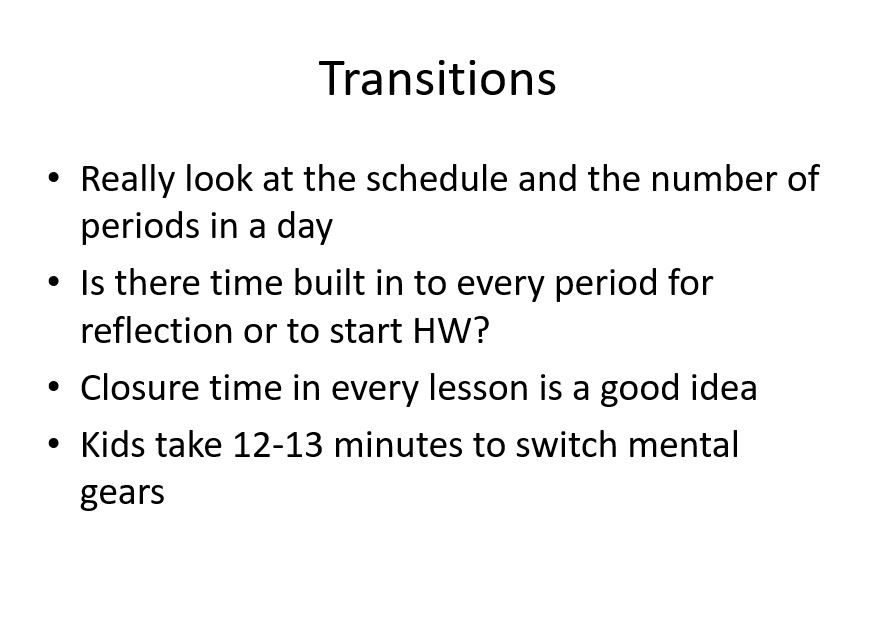
Probably the most significant example of taking on a leadership role during actual Program Development time was when Allison Luhrs and I worked (alongside Sam) to lead conversations about assessment and grading in the Middle School. This largely was generative, without a specific goal in mind. It arose in part because we were struggling as a faculty with figuring out assessment consistency, while also having to considering how drastic a change we hoped to make. We visited this topic numerous times during the 2017-2018 school year (see various notes here). Some changes (such as fuzzing out grades on Canvas) were explored, but there were not lasting all-division decisions or changes made. That being said, different teachers continued to explore this through their own practices.
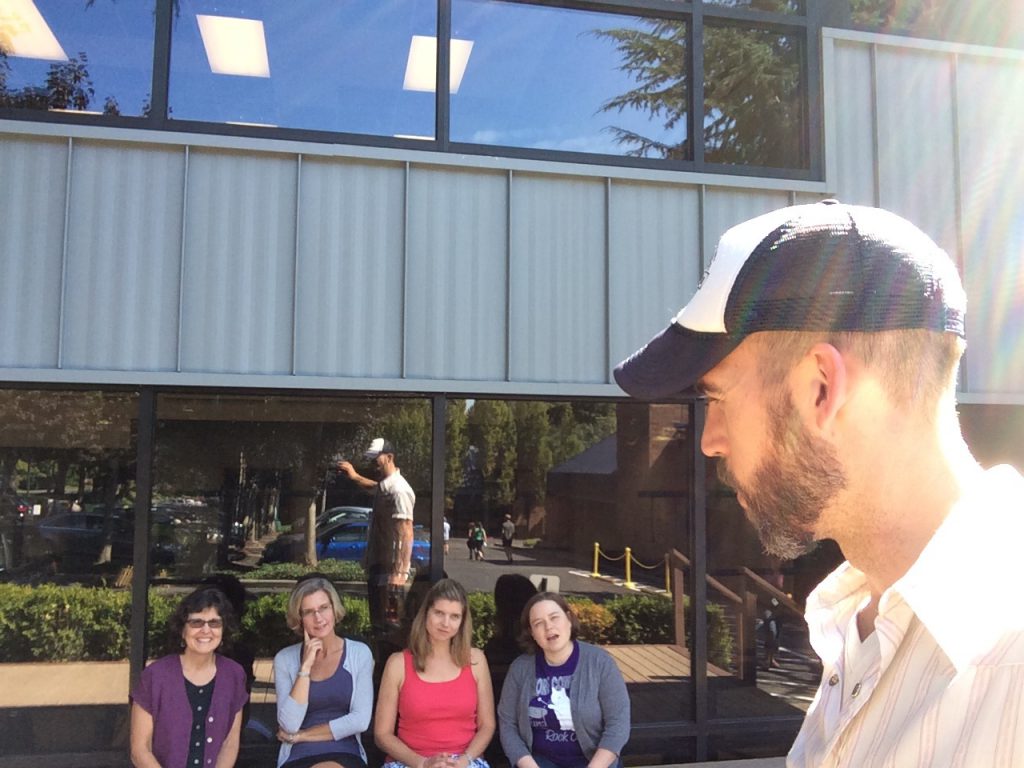
A slightly different way of contributing on a broad scale arose when I was invited to participate in the Middle School Head Search. I appreciated having this opportunity to consider the many candidates and what they would bring to our Middle School. In addition to being able to offer my perspective, I also learned a lot from this process in terms of the different components of this role. I gained a new appreciation for the complexity for this position.
“She was an awesome colleague and member of the MS Head Hiring Committee. Spoke up with her views, concerns, priorities regularly in those meetings and also was a close, active, and supportive listener to fellow teachers, parents, and administrators on that committee.”
–David Kelly-Hedrick
In a similar fashion, I have looked for opportunities to participate in the Head of School search that is currently underway. I participated in a small-group interview with Carney Sandoe representatives and also attended the slightly-larger opportunity for Middle School teachers to meet to discuss the search. These processes have with a chance to exhibit some leadership by offering my perspective. On top of that, they have been valuable as they have allowed me to step back and think about the school in a new way, and to consider what makes EPS the way it is, what aspects of our culture feel essential to carry forward, as well as areas where we as a school have opportunities to make changes as we move forward under new leadership.
“Katie lent her strong voice to the MS Head hiring committee this fall. She cares deeply about the middle school, about diversity and relationships within it, and she made her ideas known in clear and confident ways. Katie has a way of asking “the right” questions that get others thinking.”
–Karen Mills
(3) takes advantage of professional development provided by the school
The explanation I received about how this indicator is separated from the others in this category is that the professional development in this category is something that’s being offered by the school and/or specifically suggested to EPS faculty. This is in contrast to broader professional development opportunities, which I’ll address in the following indicator.
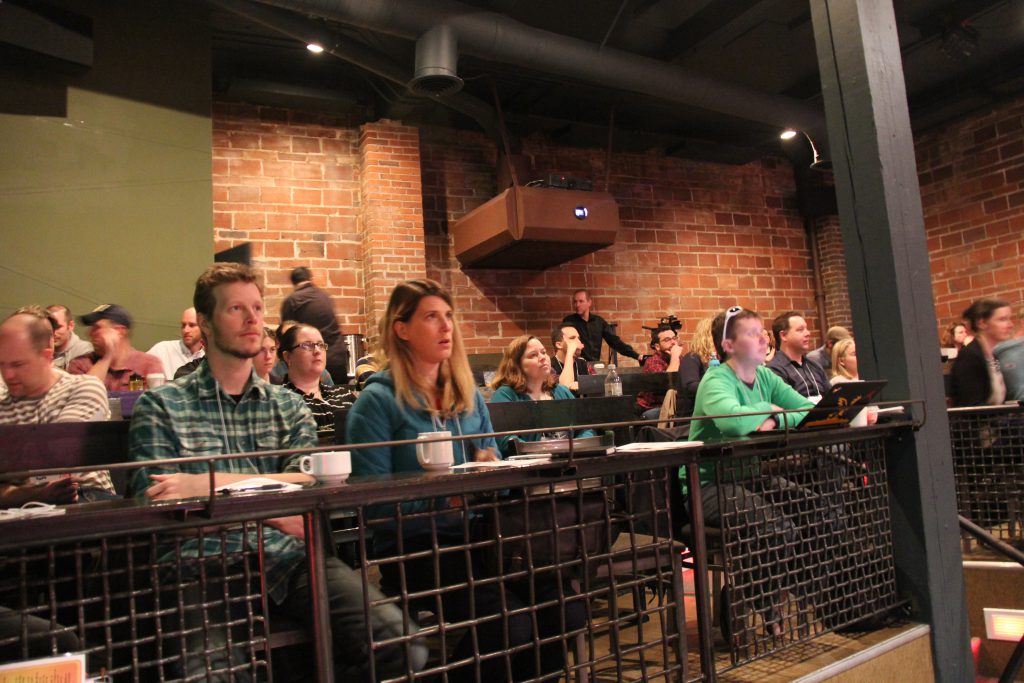
I have done this right from the get-go, when I was able to participate in the then-PNAIS (now NWAIS) Beginning Teacher Institute in February of my first year at EPS. This offered a helpful perspective to those of us who were new to teaching, particularly at independent schools. One thing that stuck with me from that institute was the clear statement that our leaders didn’t expect us to be perfect in our first year of teaching at their schools. Instead, they knew we had areas of strength and areas that needed improvement, and they were there to help us develop in our roles. While I think I probably had some intuitive sense of this, hearing it said out loud, explicitly, helped lift a weight off of my shoulders and helped me feel more strongly supported by Terry and Sam and a little less worried about some less-than-ideal parent interactions I had during that first year.
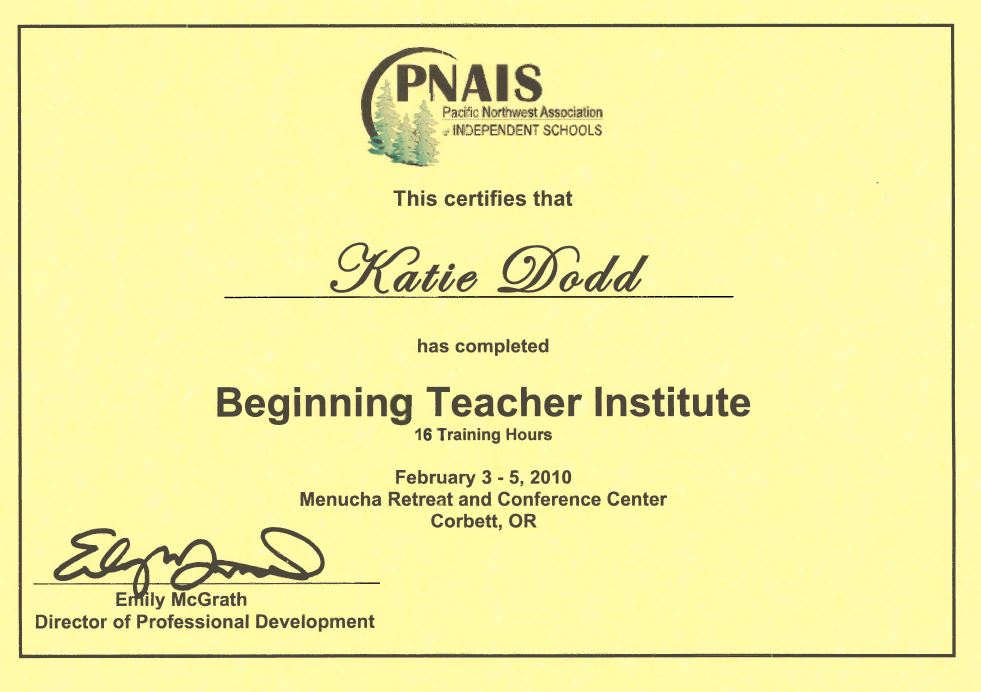
As mentioned previously, my second year at EPS I was lucky enough to get to go to the Learning and the Brain conference in Terry’s stead, as something came up last-minute that prevented her from going. The conference that year was “iGeneration: How the Digital Age is Altering Student Brains, Learning & Teaching.”
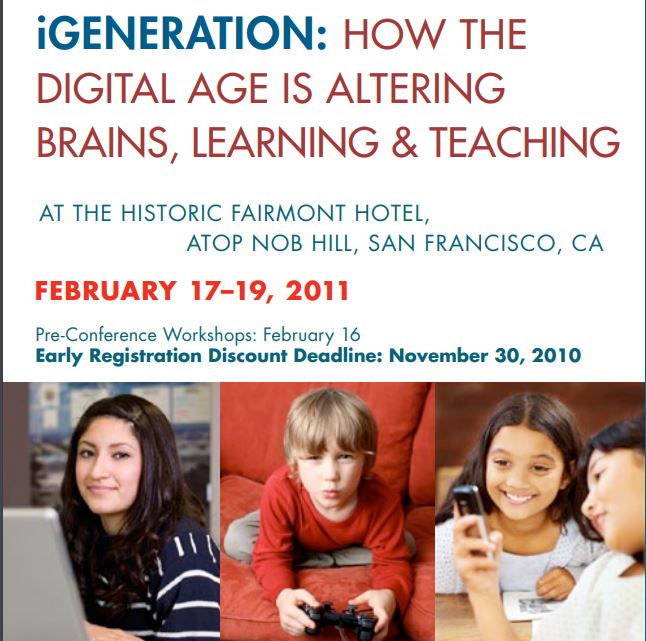
I was able to learn a lot about the connection between the science of the brain as well as its connection to the student experience. Much of this information was new to me and I appreciated the opportunity to strengthen my understanding of these topics.
In summer of 2021 I was part of the EPS cohort who participated in the “Joy of Advising (Course 1)” remote professional development run by IFSEL (the Institute for Social and Emotional Learning). I did this because I thought it would be helpful to shore up some advising practices and philosophies.

This was an opt-in experience offered to EPS teachers, but to my mind something like this should probably be required for anyone who will be serving as an advisor, especially if this is a new role for them. It can feel really daunting to take on this kind of work, and having something like this under one’s belt would likely make people feel more secure in this role. I suppose one challenge comes in that this was done over the summer, so people had to give up some of their spare time. Perhaps it could be incorporated into the opening meetings somehow?
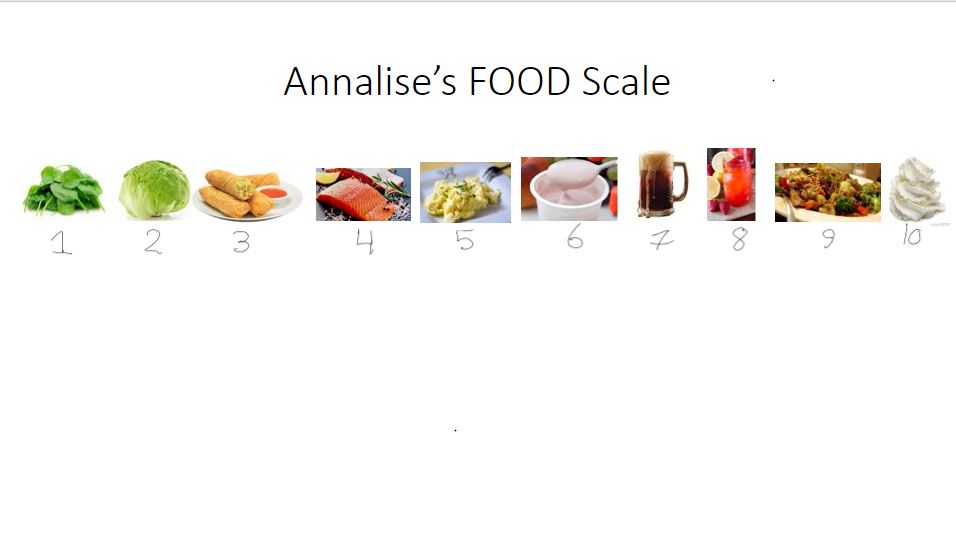

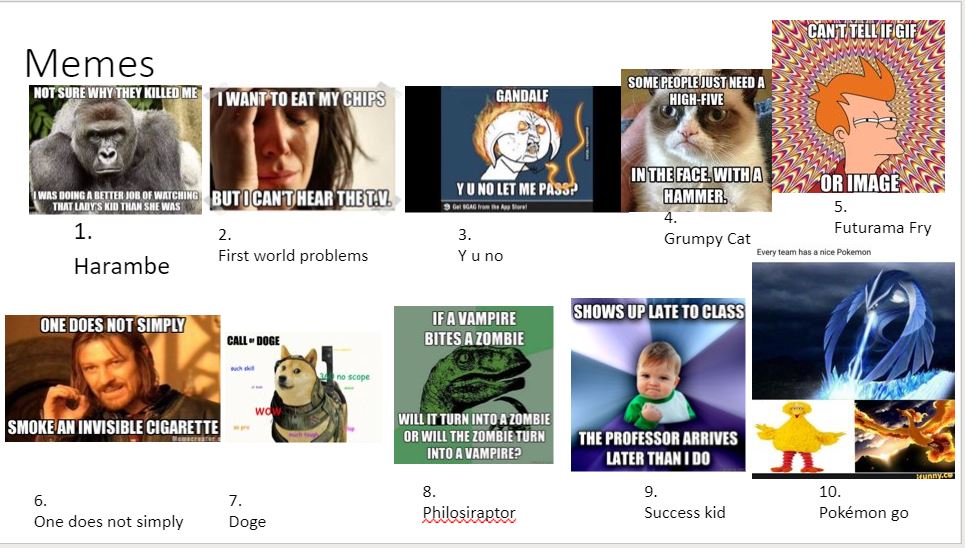
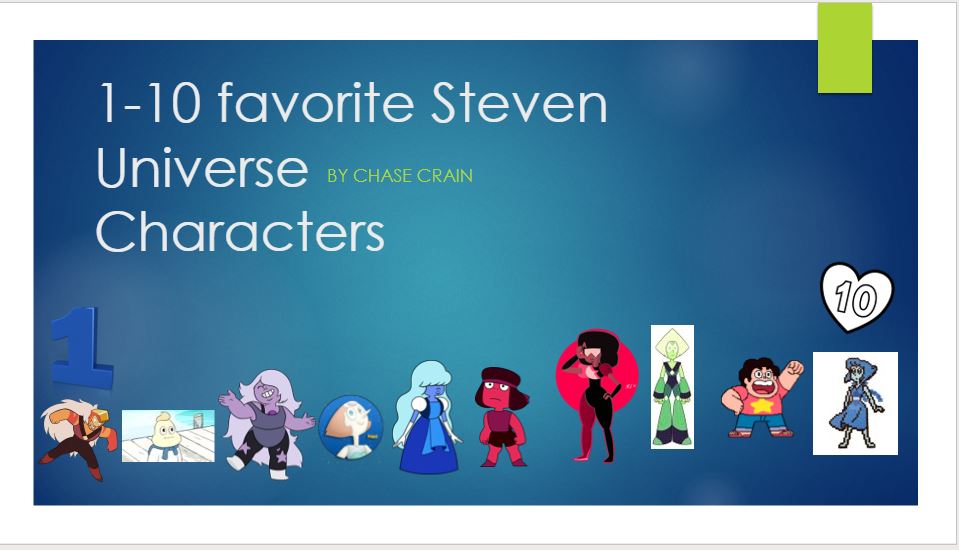
In the 2019-2020 school year I was fortunate to be selected to attend the NAIS People of Color Conference as part of our school’s faculty/staff delegation. As part of this experience, I participated in a day-long workshop prior to the start of the conference addressing my role and responsibilities as a white person moving through that space. The entire conference was quite informative and I greatly appreciated having the opportunity to attend.

However, I would not want to go to this particular conference again in the future as I felt that it truly wasn’t intended to be a place for white allies. It’s my hope that NAIS devises a way to perhaps have a parallel ally conference happening at the same time in the future to preserve these spaces for people of color, as they were originally intended.
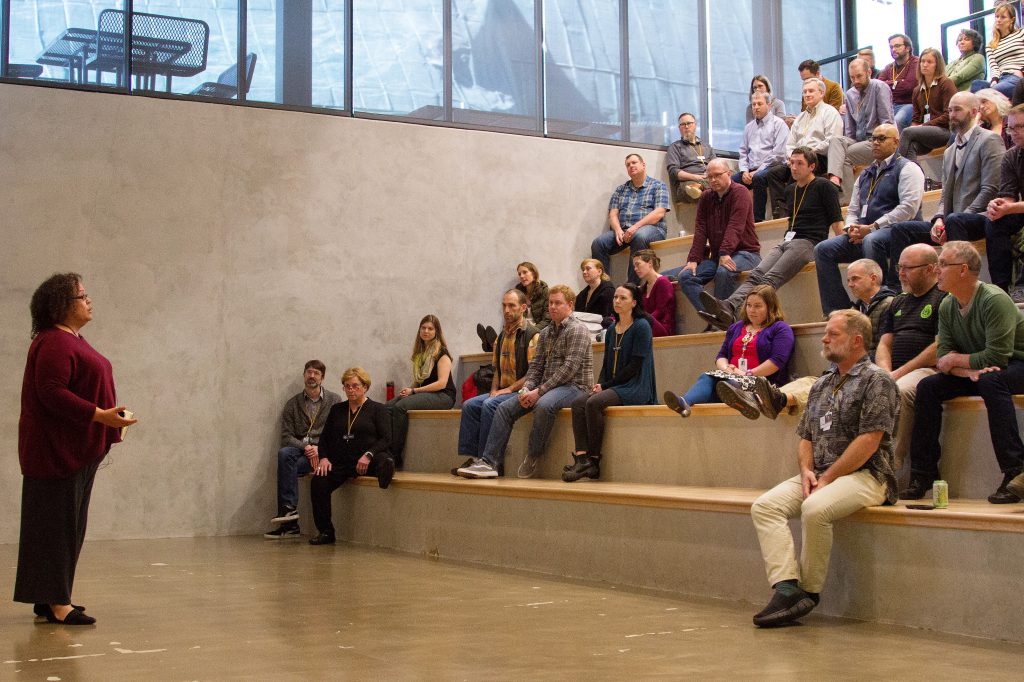
The most significant of these opportunities has been my participation in the PDP. I had some trepidation about this experience, but still stepped up when it was offered to me. My choice to go through this process was not only to consider how it could be personally valuable to me and my teaching, but also to think about how my experience and feedback might be able to help shape this process moving forward, as this is still in its early development (I am part of the second cohort).
Basically, I think of myself as a beta tester for the PDP. To that end, I have tried to respectfully push back on aspects of this process that seem confusing or inauthentic to me. I know there has been a great deal of thought put into the framework of the PDP but I also believe that there are ways for it to be better, especially as the school looks to expand the number of people moving through the process in any given year. One aspect of that is how scalable this really is. We’ve had only groups of 5 or 6 teachers participating, but it’s my understanding that the hope is to start having larger cohorts, perhaps as many as 14. That intent makes me think more critically about what the expectations are of this program, and how it might work with larger numbers of people participating, which by definition will require much more time invested by faculty.
I also hope to be able to serve as a resource for people who are considering or participating in the PDP in the future. After a few casual discussions I realized that many people were unfamiliar with the program, so I wanted to offer an opportunity to connect.
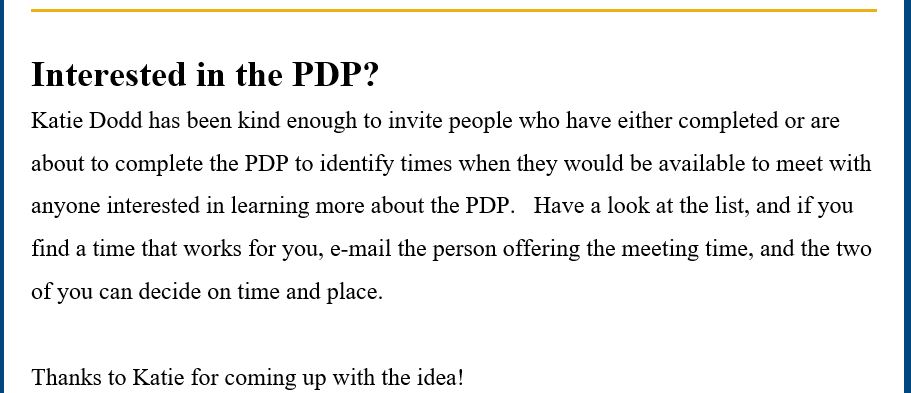
No one reached out to follow up but I hope that this at least establishes a precedent of connection between different cohorts. I know there will be many opportunities to serve in an “official” capacity such as being a facilitator or serving on a team, but I think there is much to be offered even in casual conversations about the process.
(4) identifies and pursues professional development opportunities appropriate to enhancing effectiveness as an educator
I have taken advantage of numerous outside professional development opportunities over the years, several of which occurred early in my time at EPS. Those included a week-long ASM Materials Science course in summer 2010 (which was particularly relevant when I taught the 6th grade Science curriculum), and participating in the NSTA Conference when it was in Seattle in fall 2011.
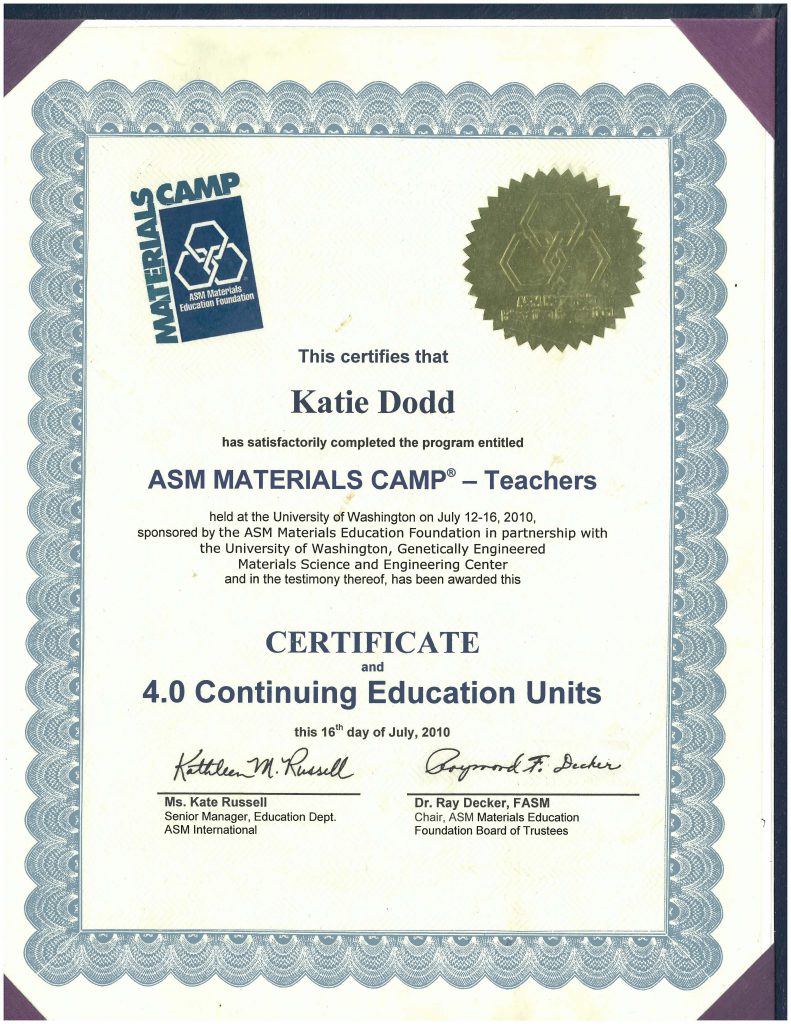
In the summer of 2018 I participated in a week-long on-site program at the Monterey Bay Aquarium, which was their Project-Based Science Institute (PBSI).
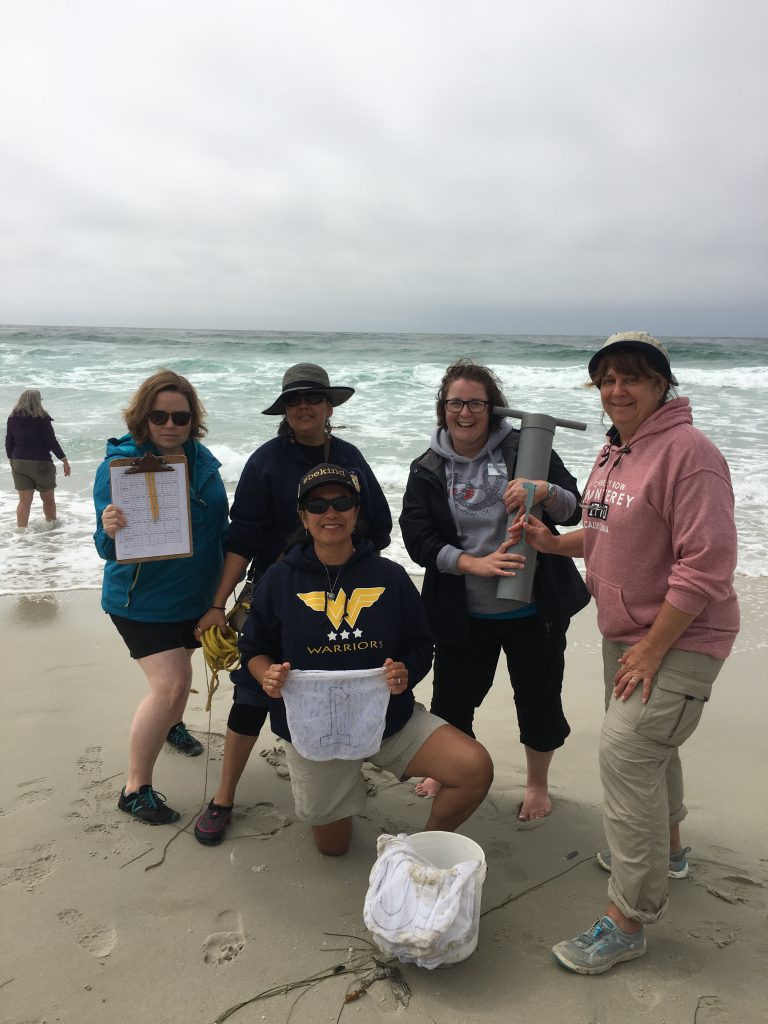
In January 2020 I attended a workshop in Baja California on whale sharks and microplastics.
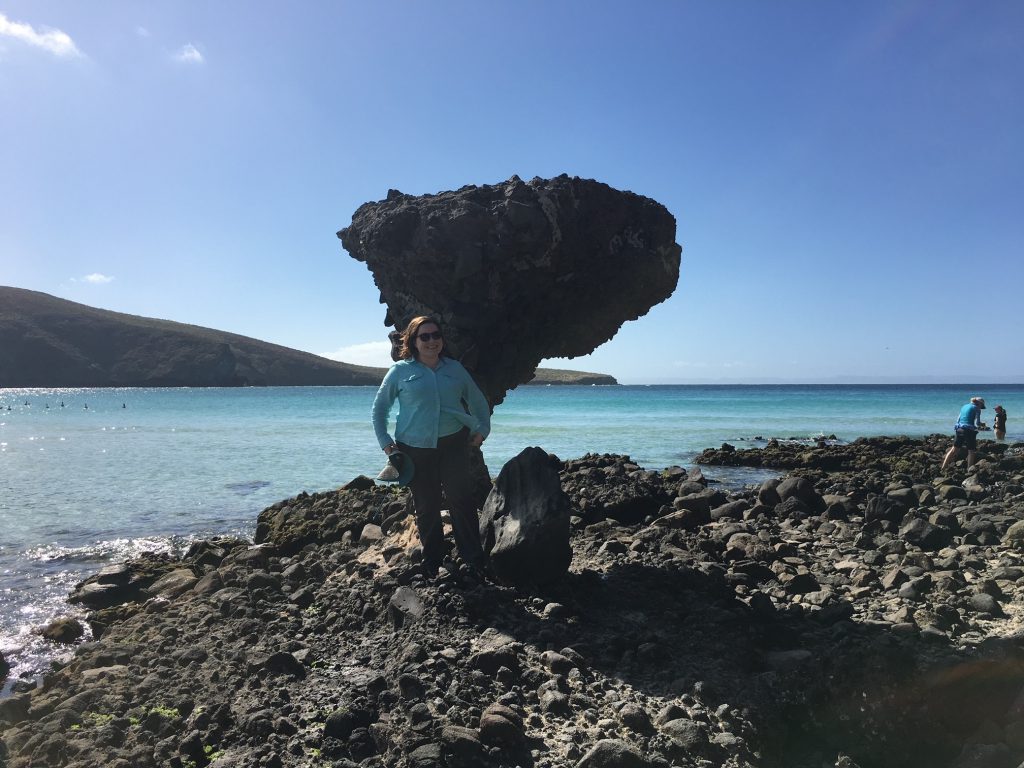
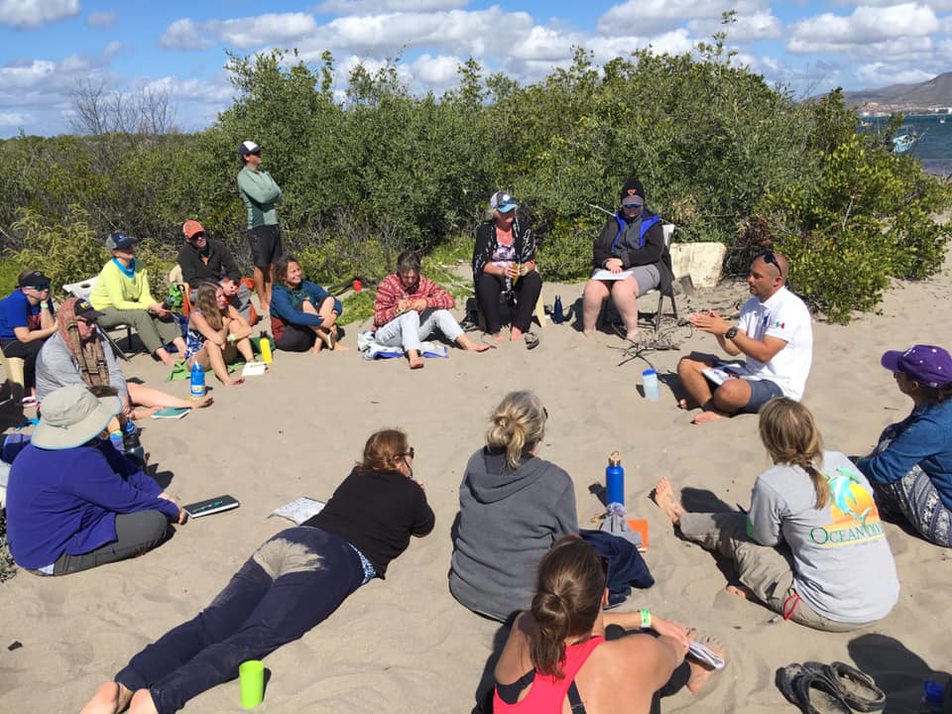
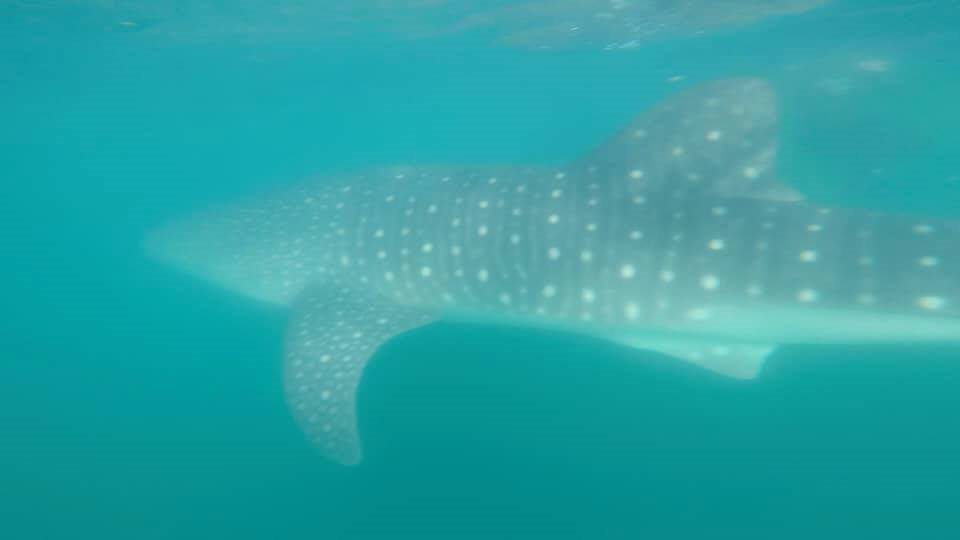
With the advent of the pandemic, many of these opportunities moved online, which actually made it easier to access some of them. I’ve participated in at least 13 professional development opportunities since the school went remote in spring of 2020 (details here).
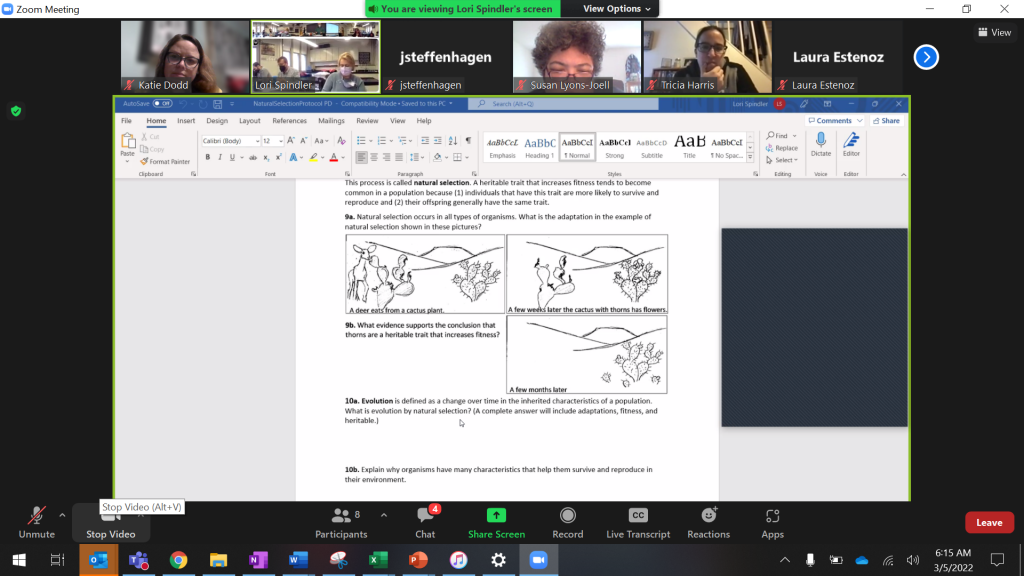
These have covered a variety of topics, ranging from specific science teaching strategies (including suggestions for remote work as well as things that would work back in the classroom, such as nature journaling). I’ve also participated in several workshops connected to social justice, whether in a more general sense or sometimes connected explicitly to science teaching.